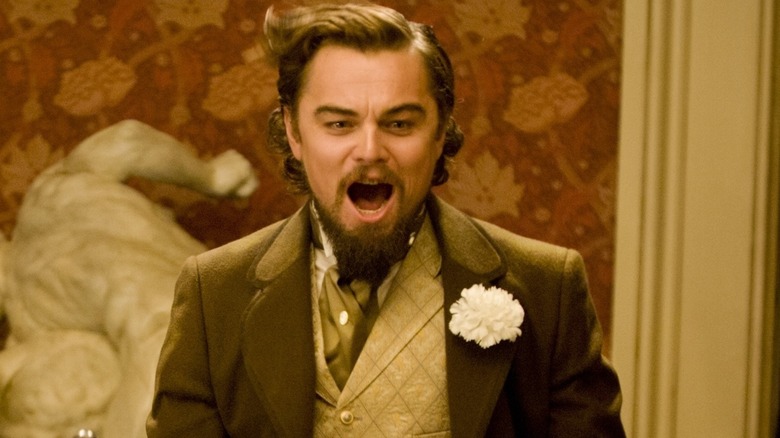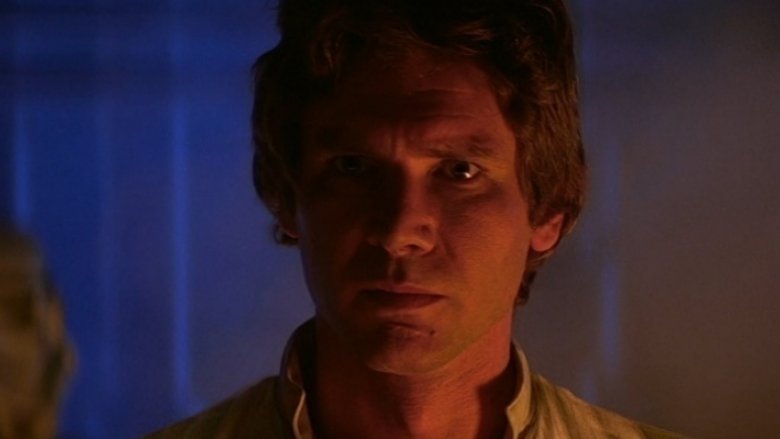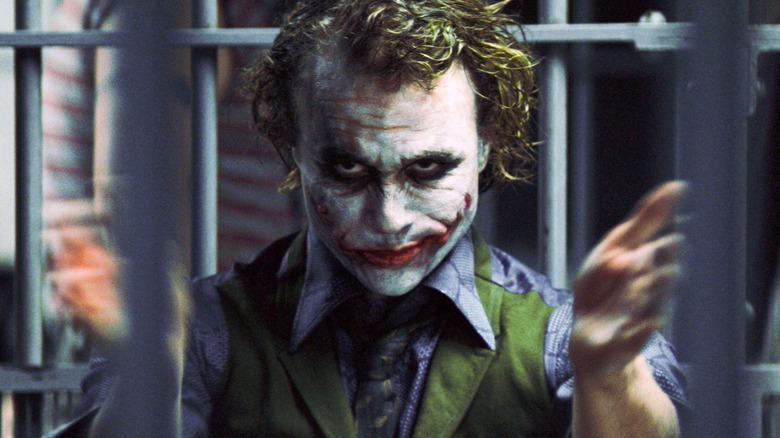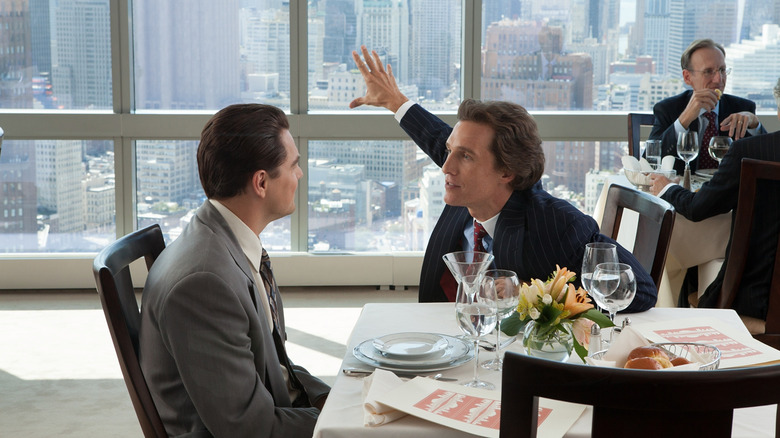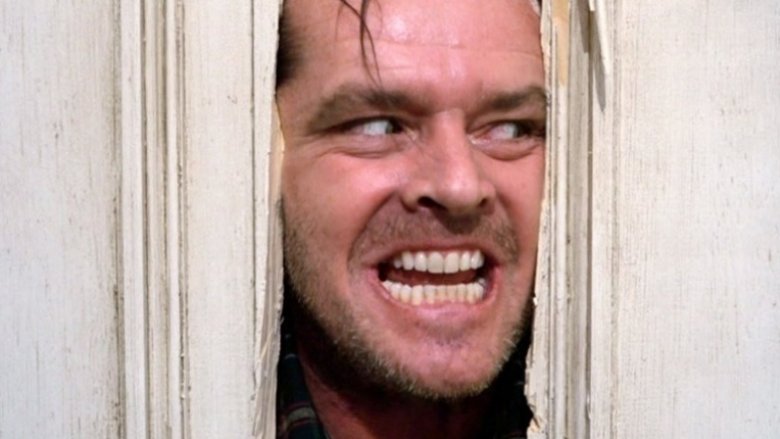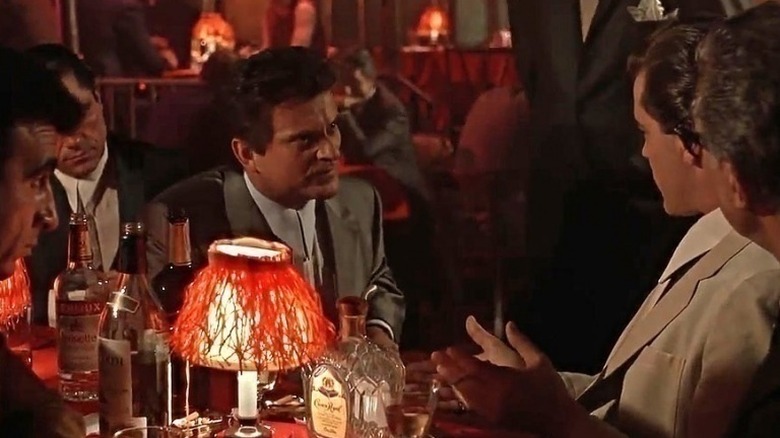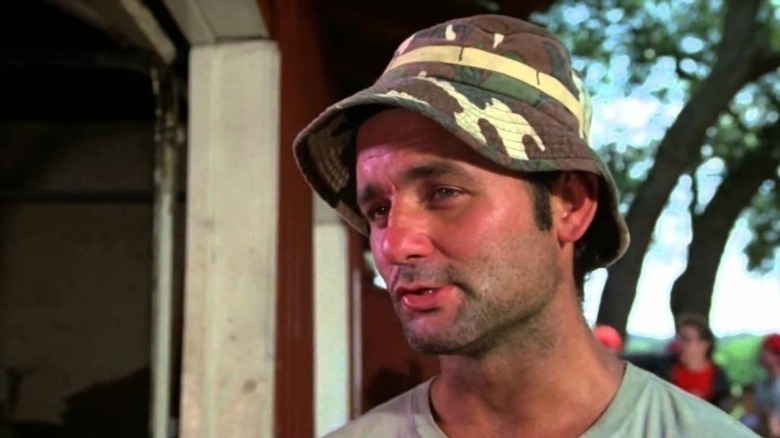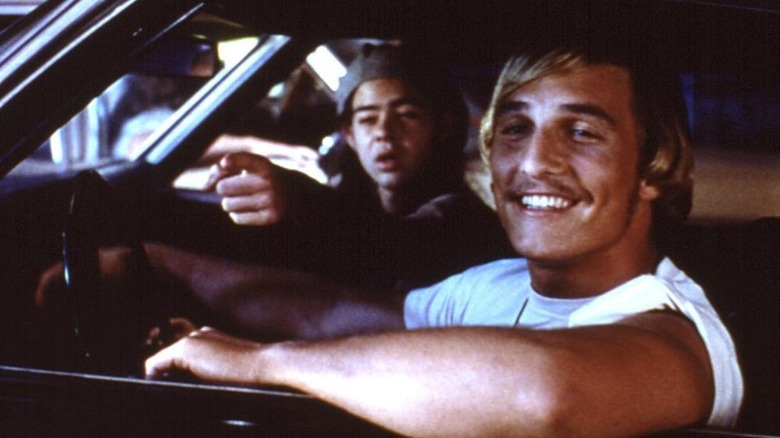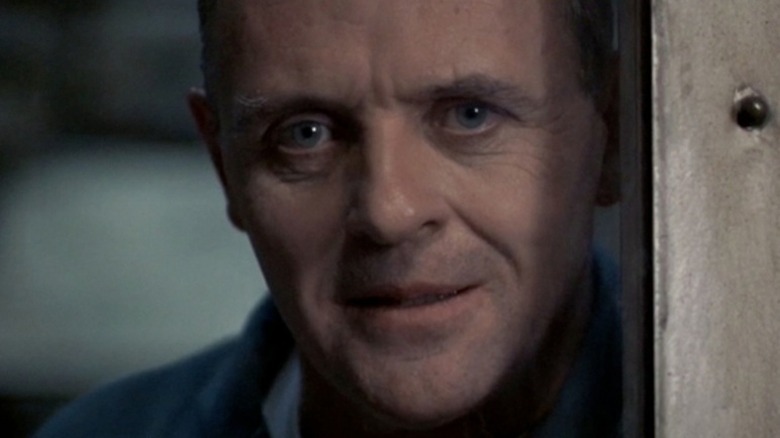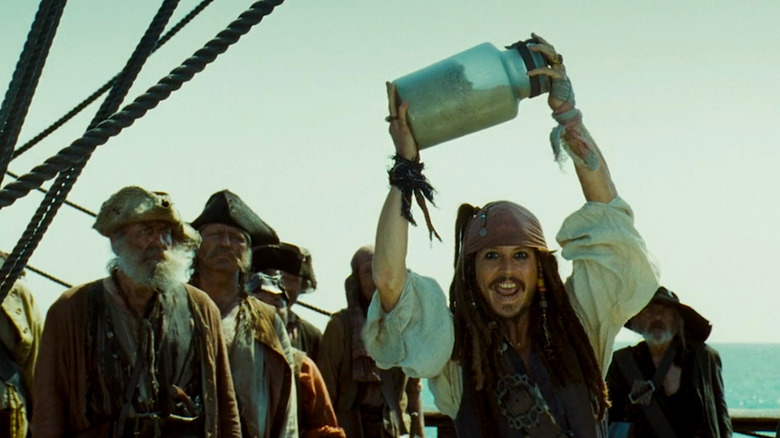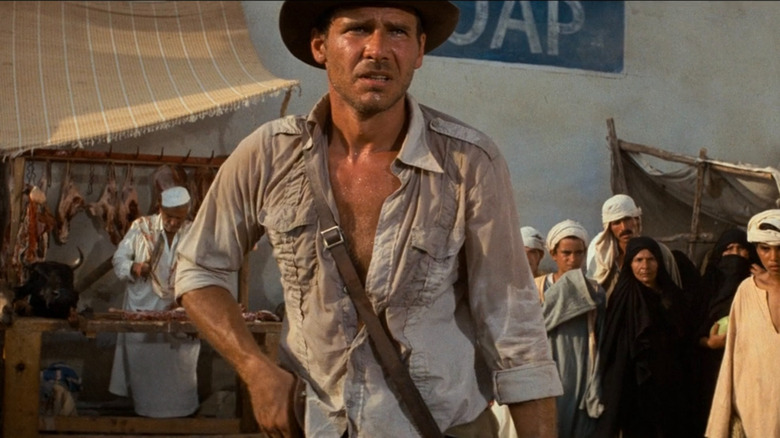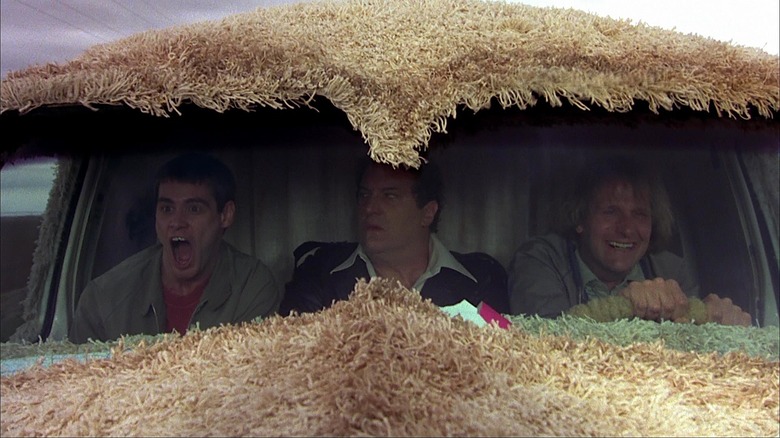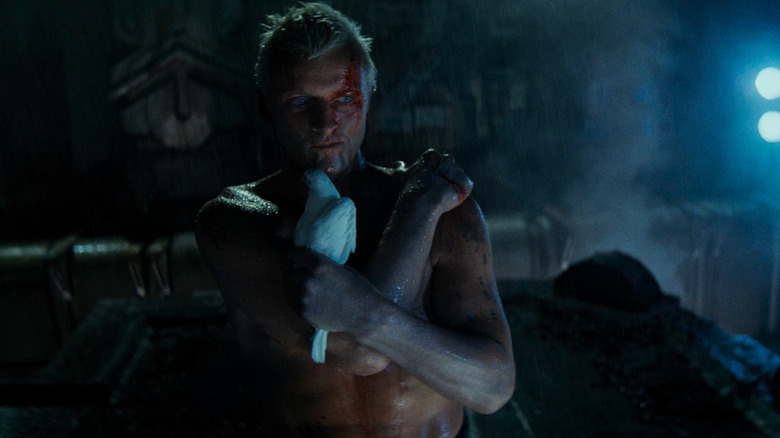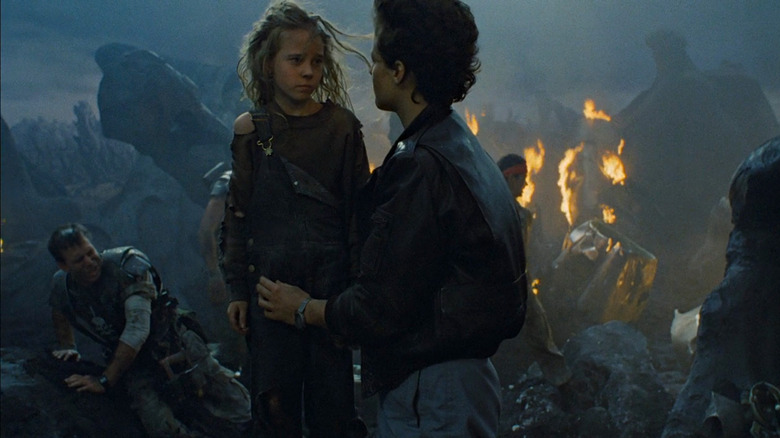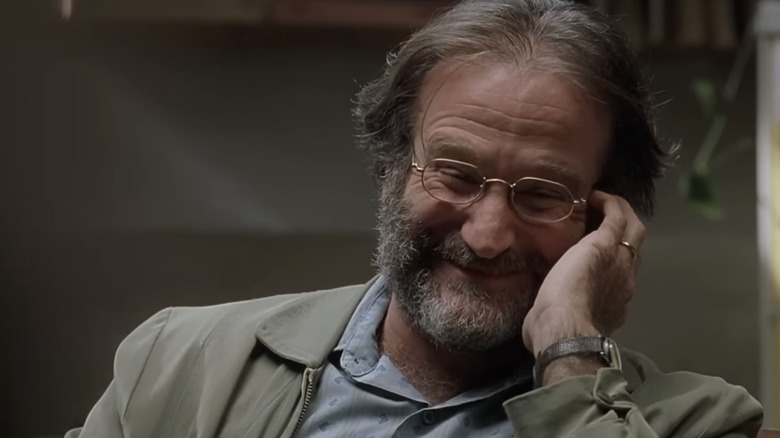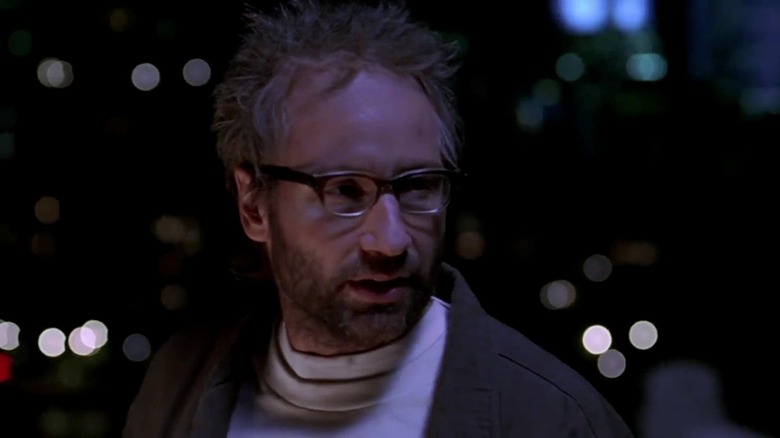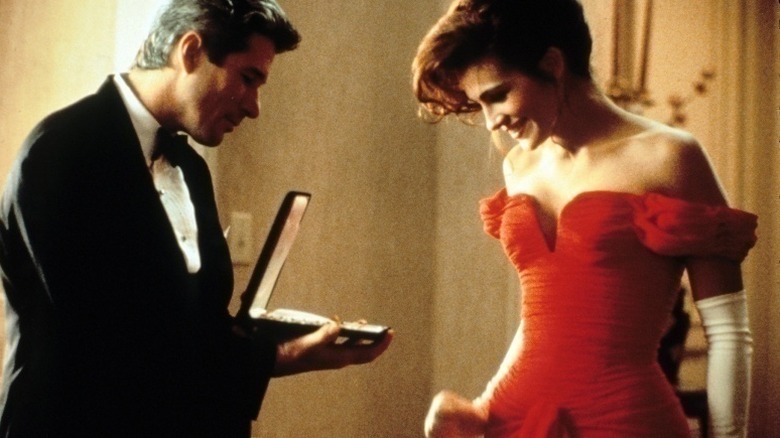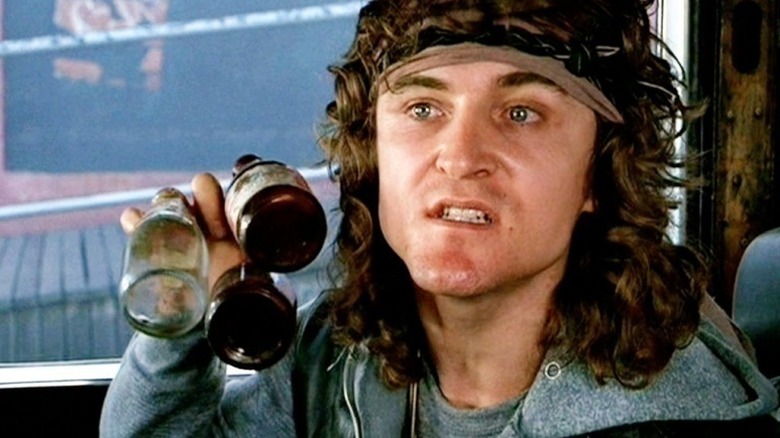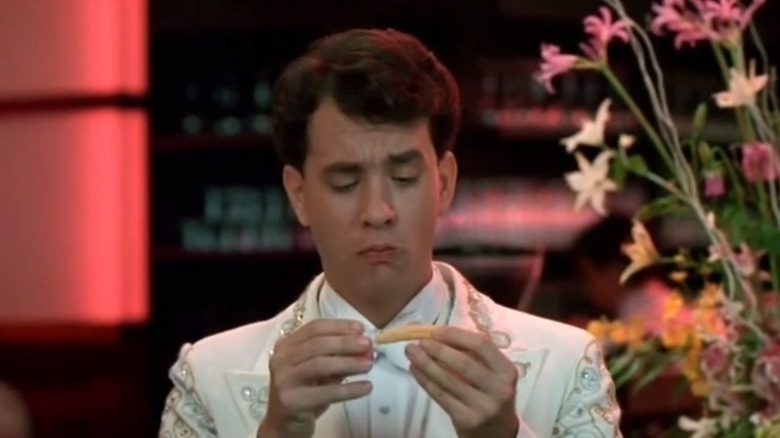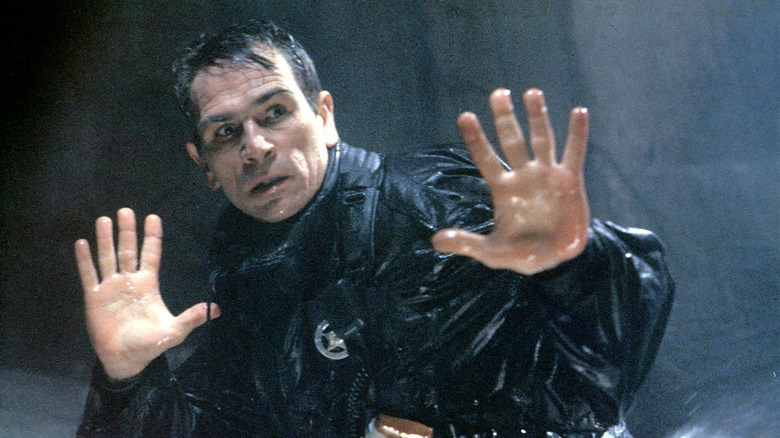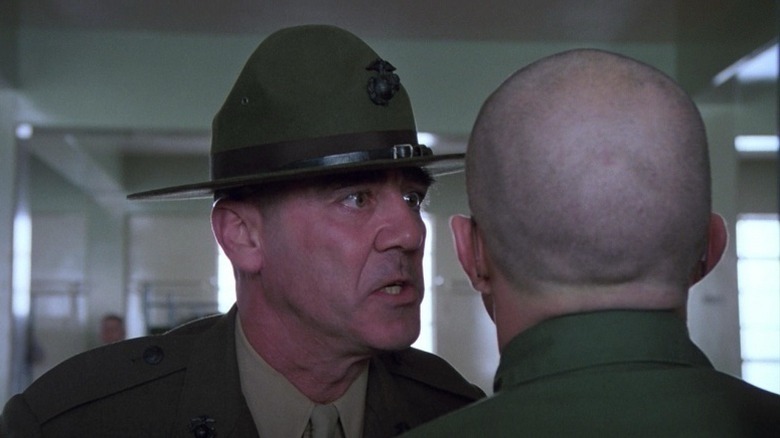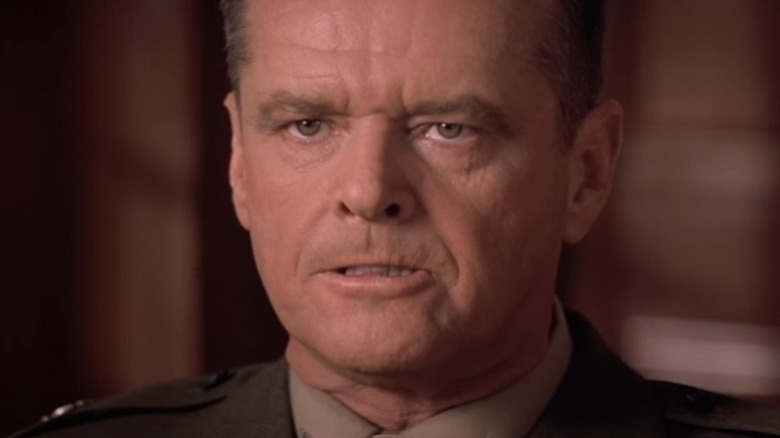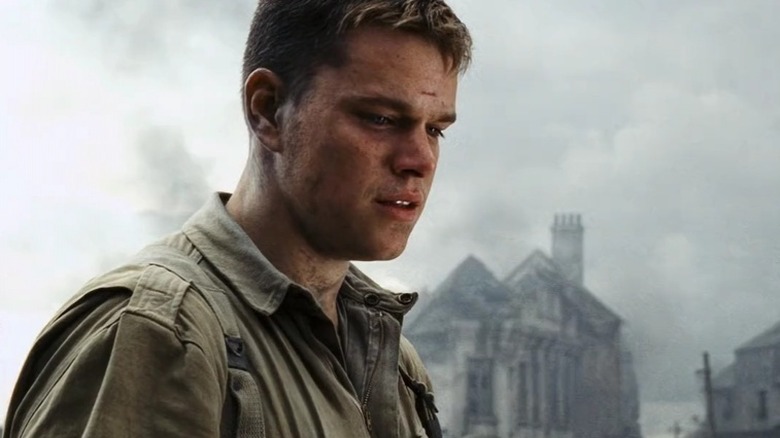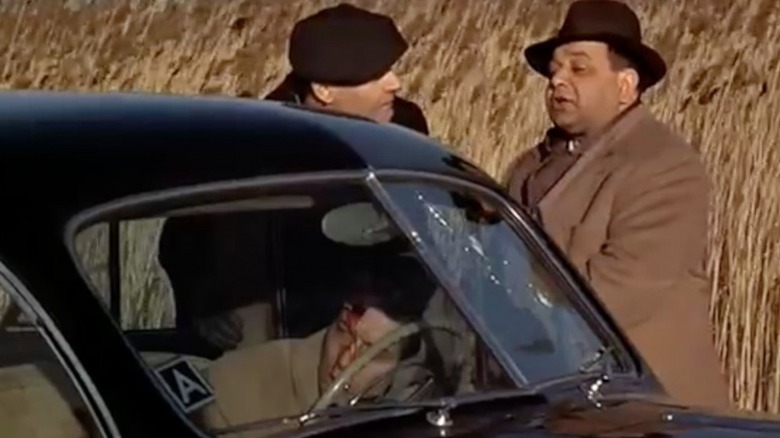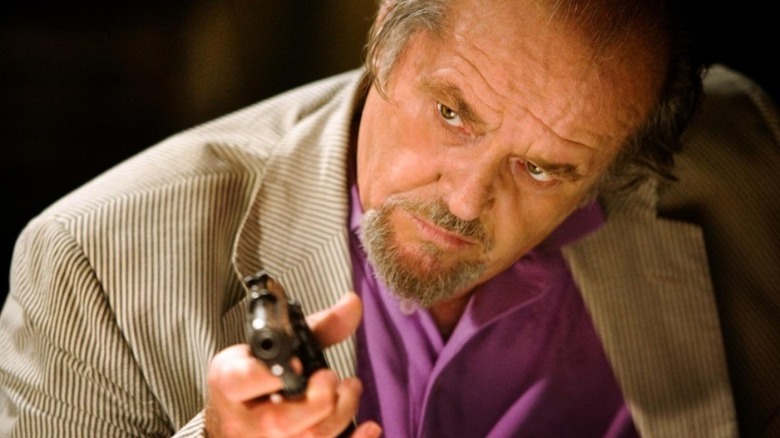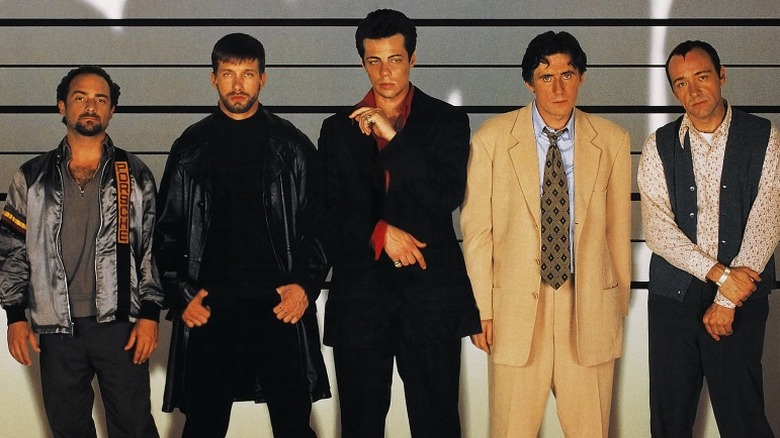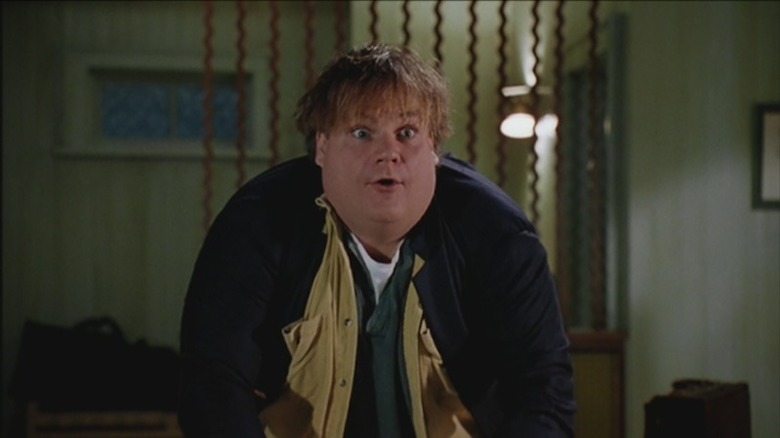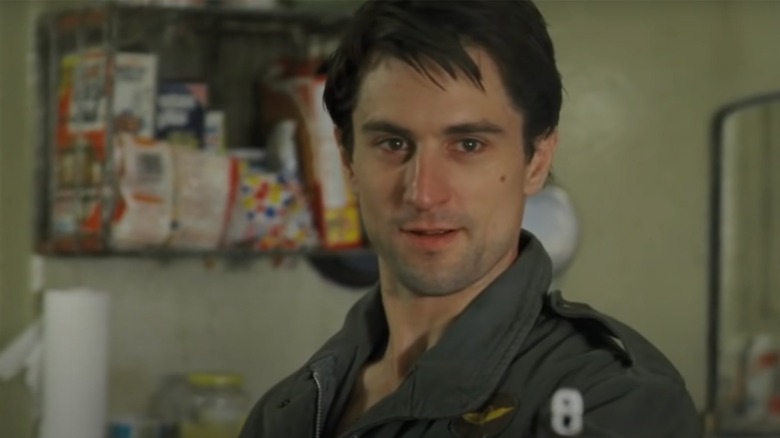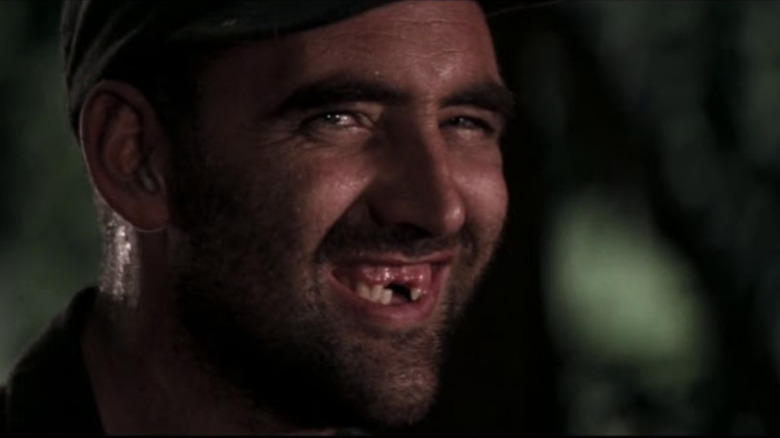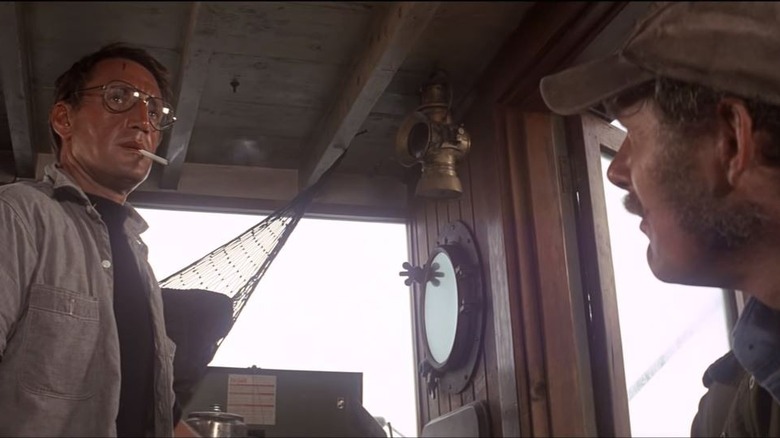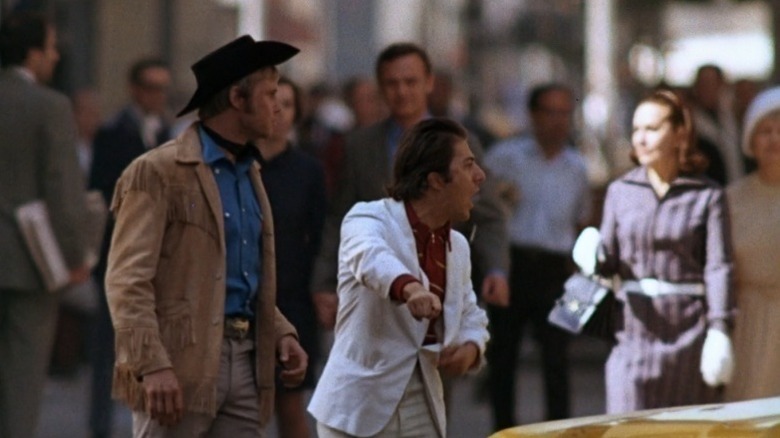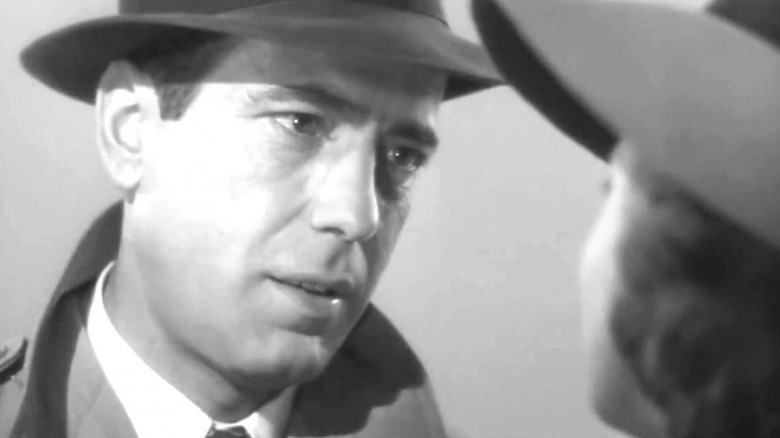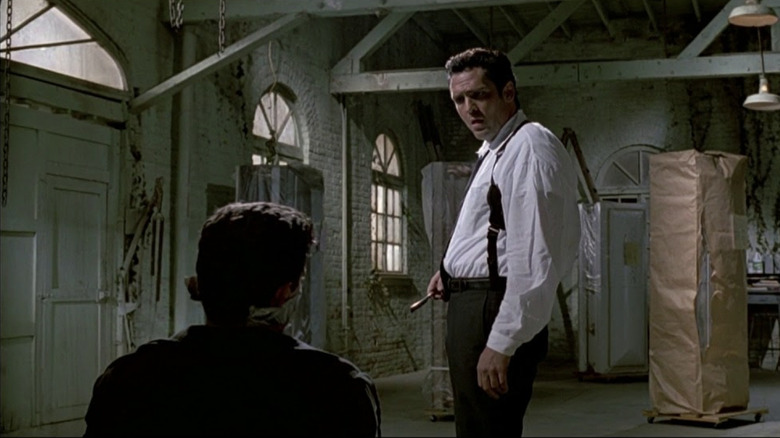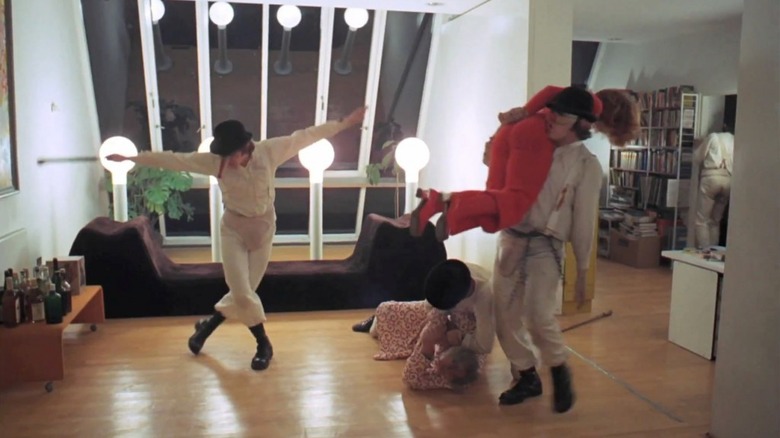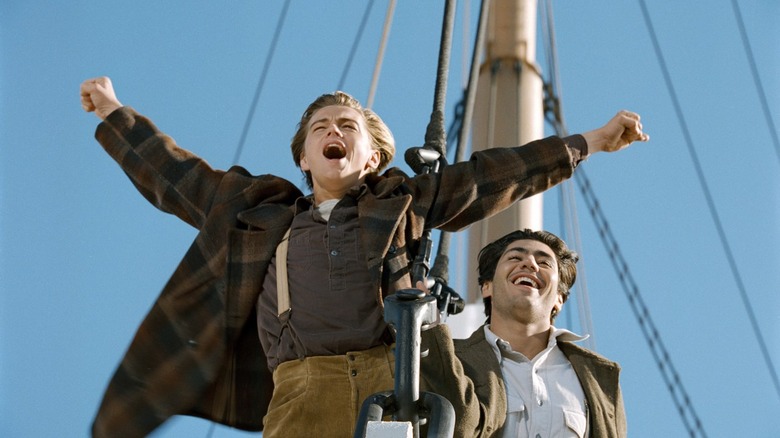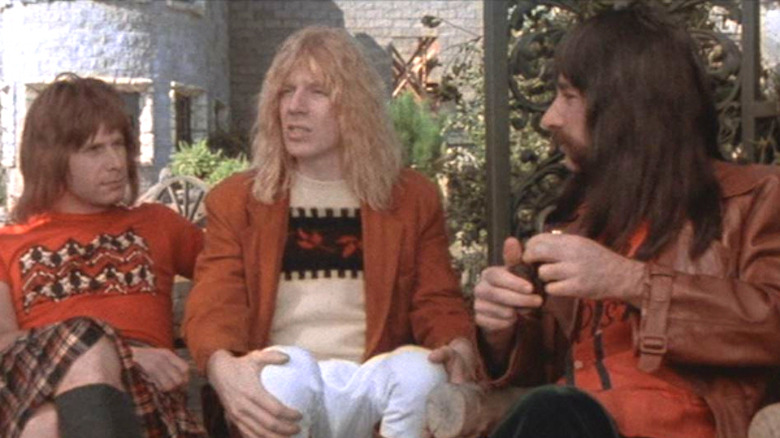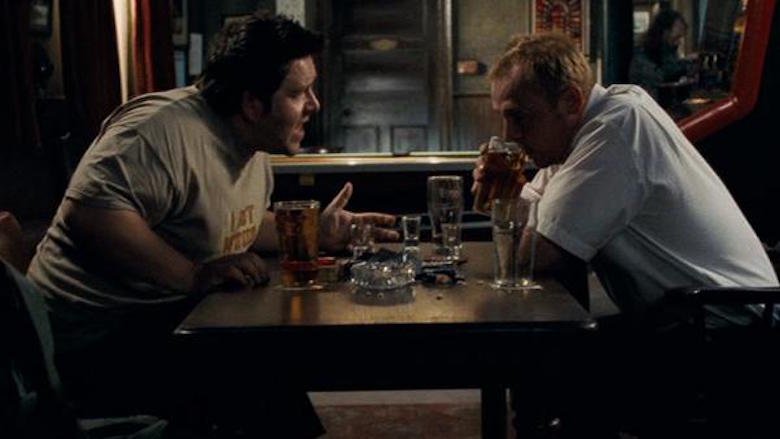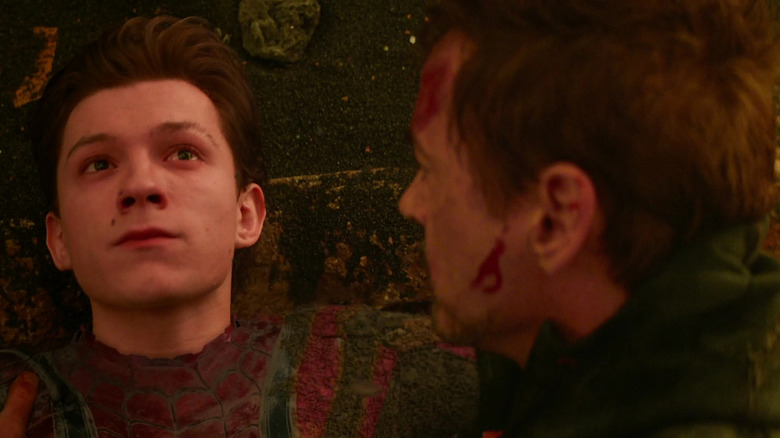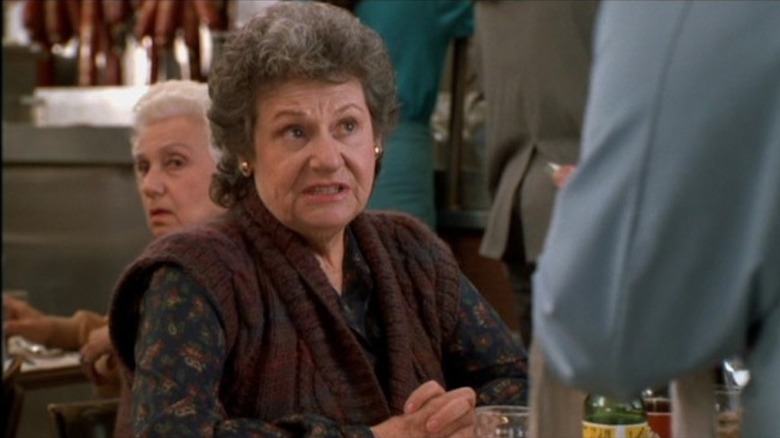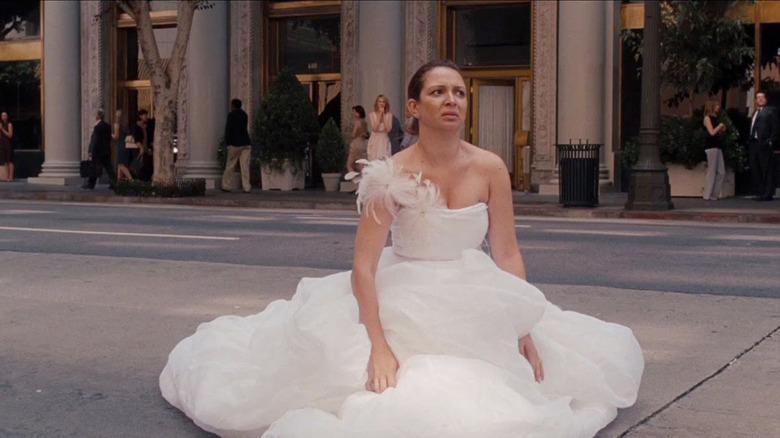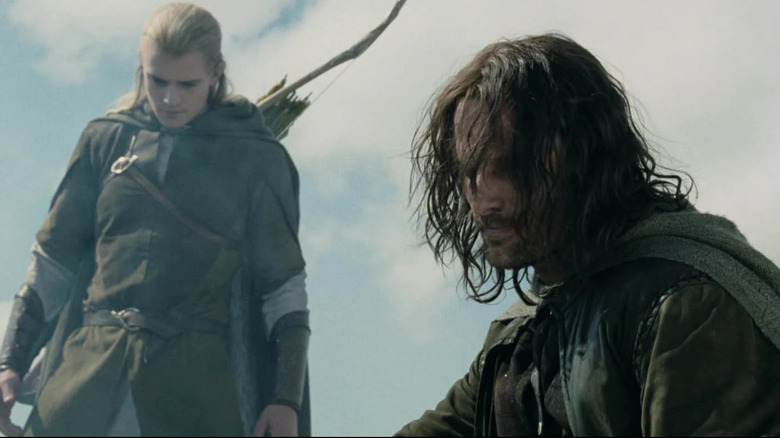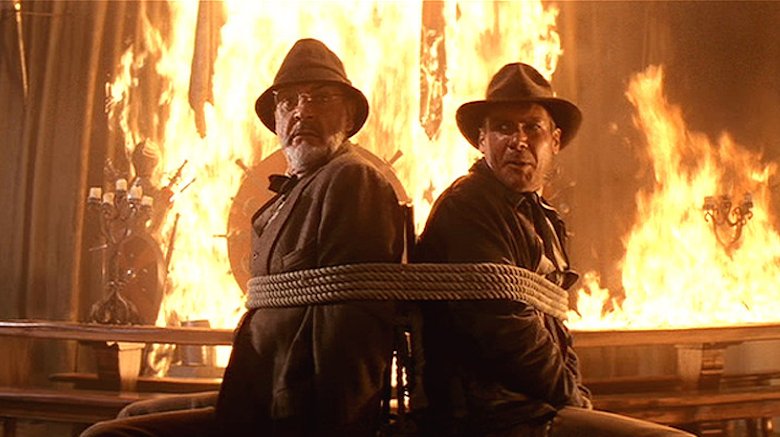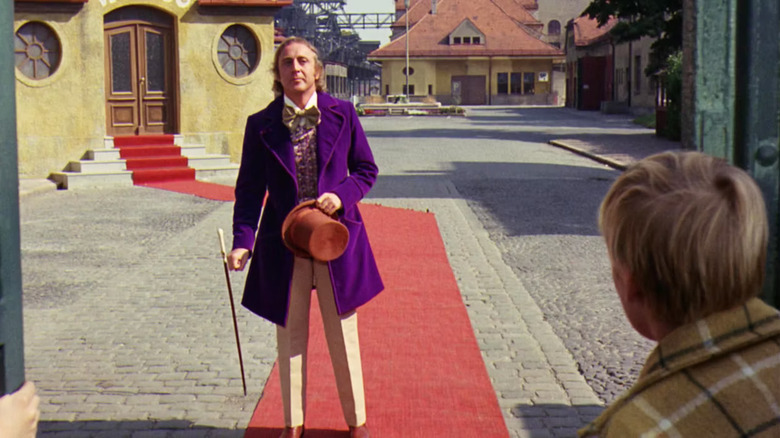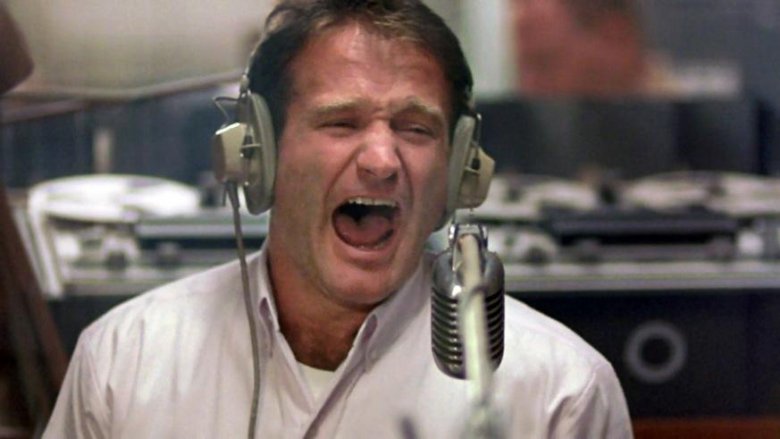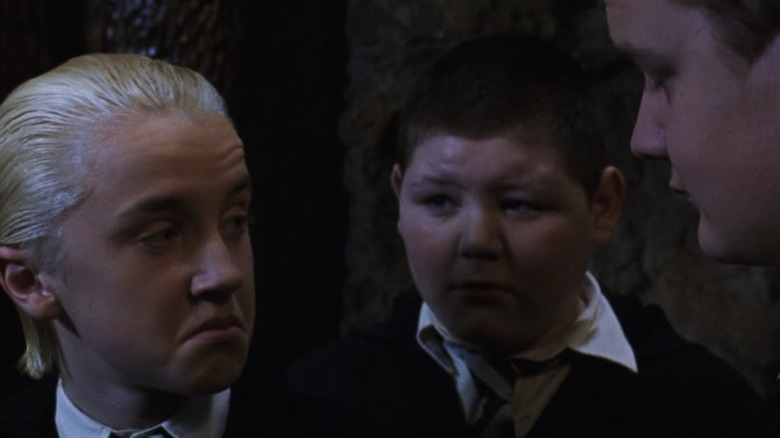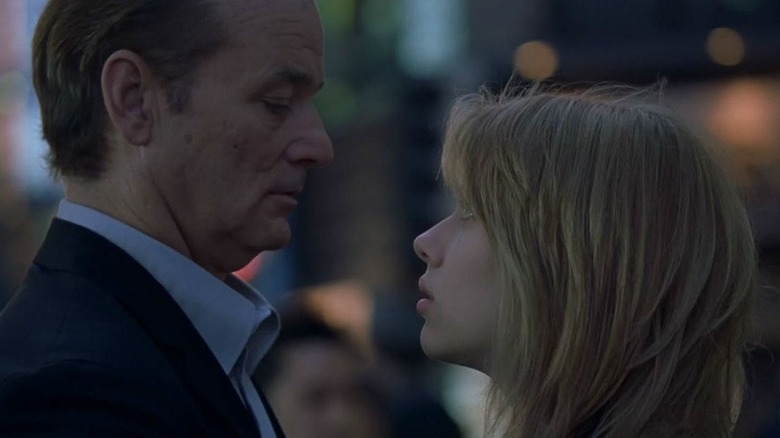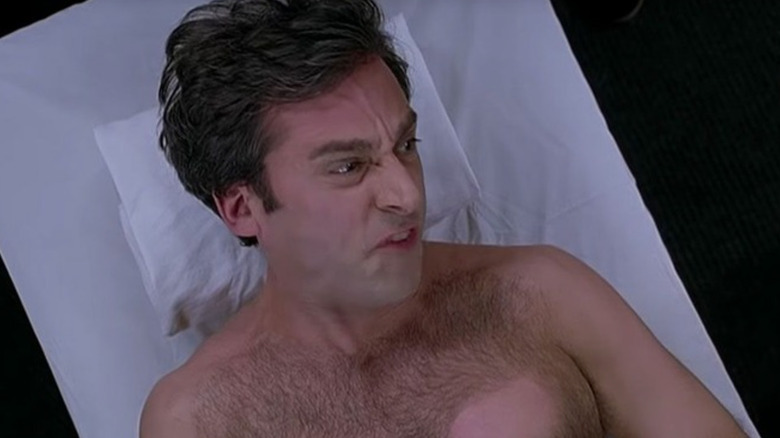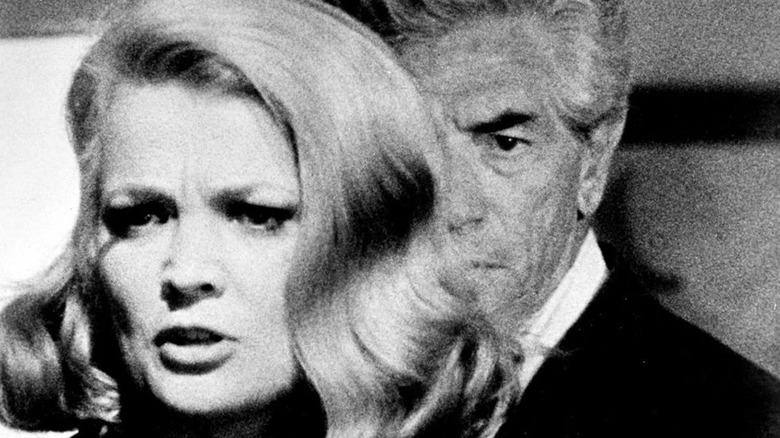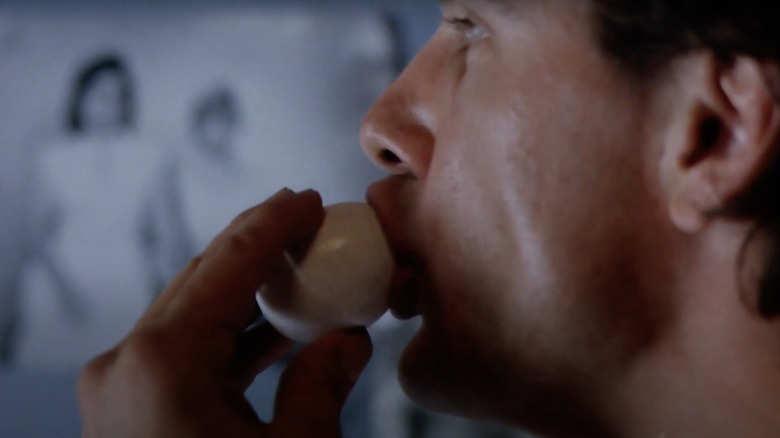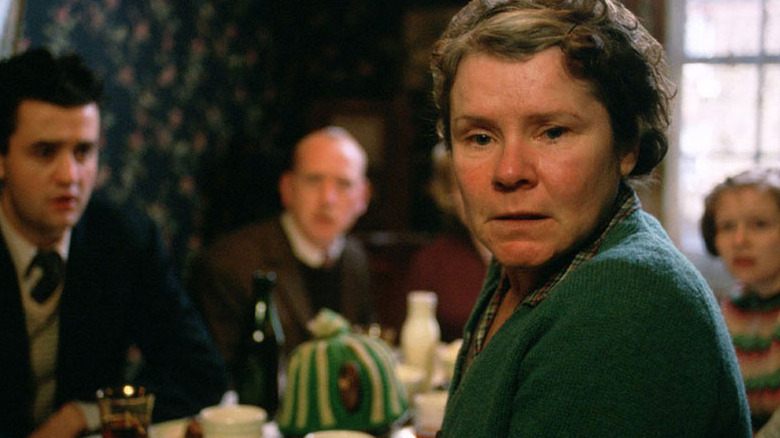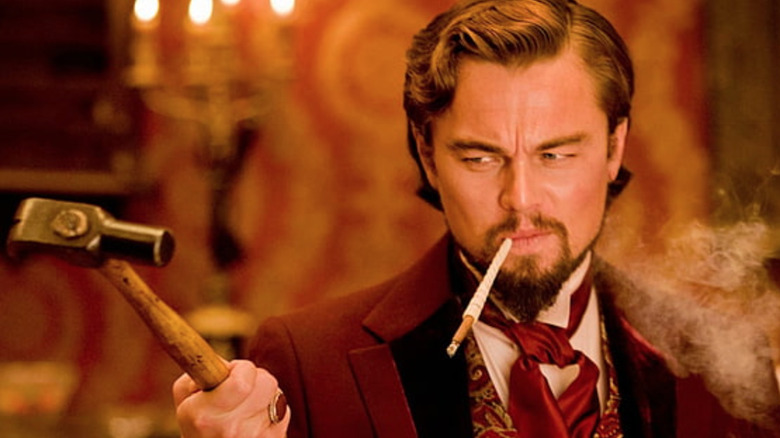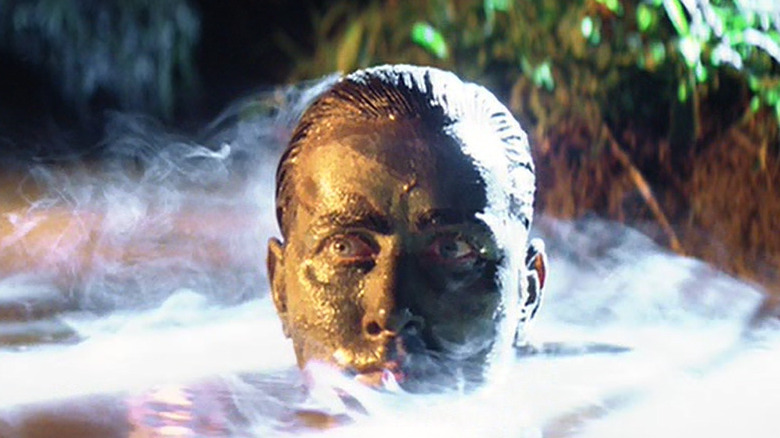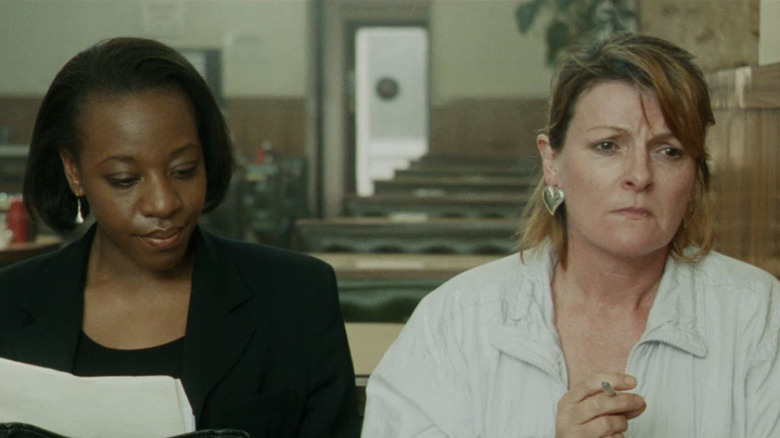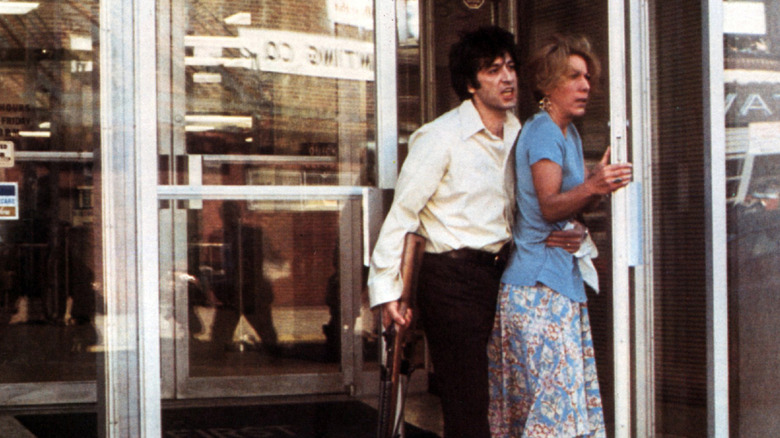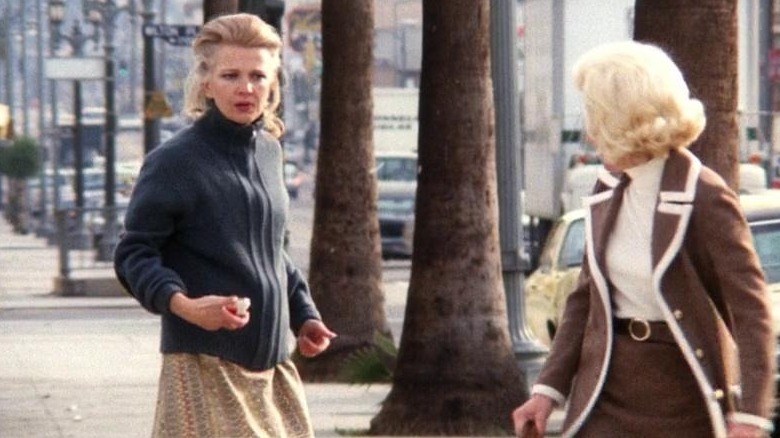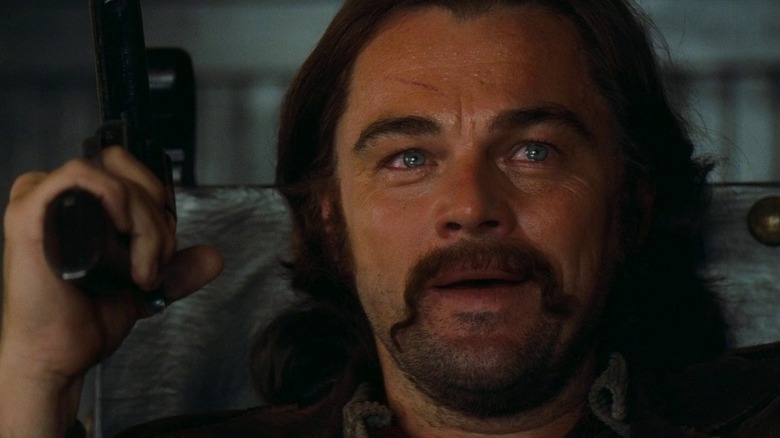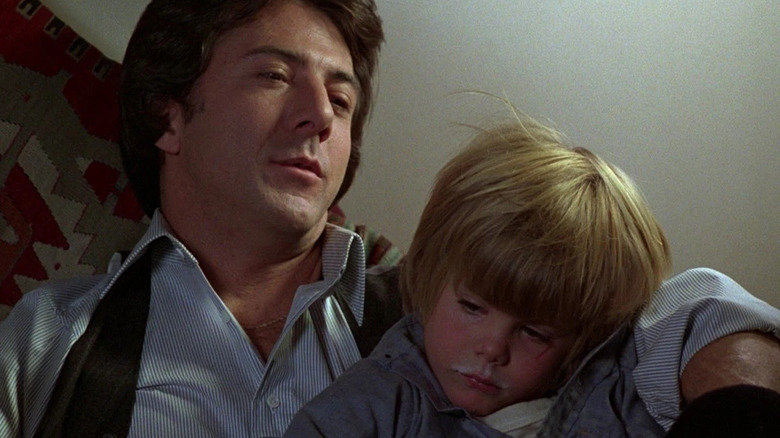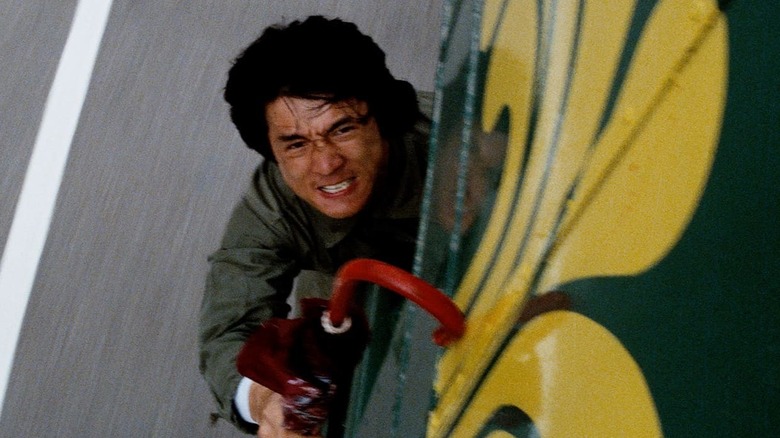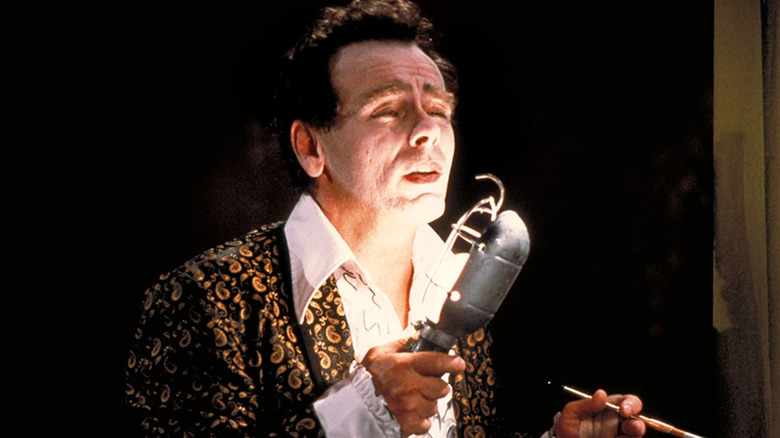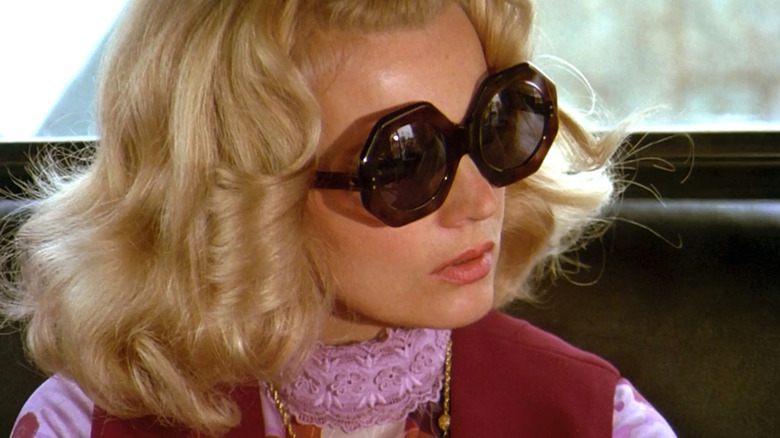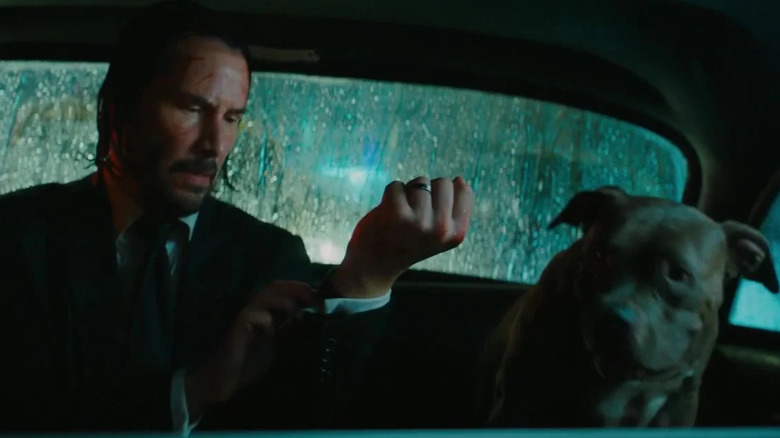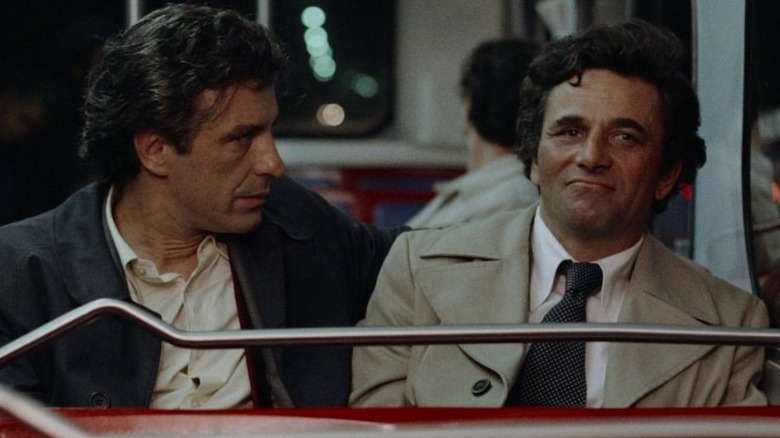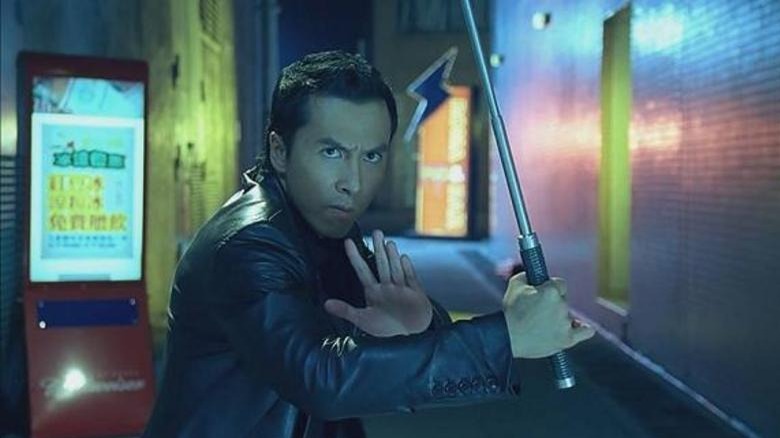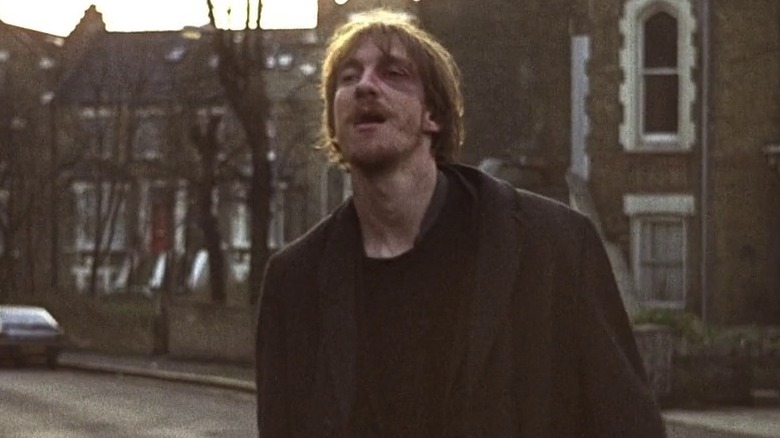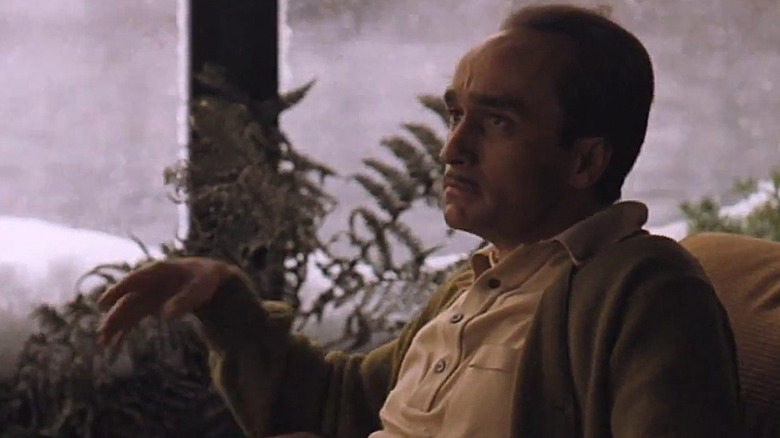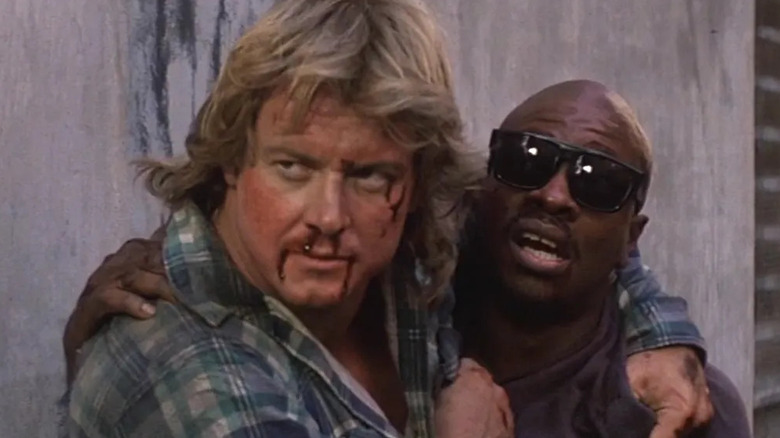Best Improvised Moments In Movie History
Let's take a moment to stop and pour one out in honor of screenwriters. Not only are they often left out of the spotlight when a movie is really good, it turns out that sometimes they don't even deserve the credit — some of the best lines in movie history were actually improvised by the actors. How frustrating must it be for those poor screenwriters to slave away on a script, only to have an amateur come in and make up the perfect line off the top of their head — and revel in the glory and acclaim when the line finds its way into not just movie history, but the pop culture zeitgeist itself.
Well, either way, their loss is our gain. Here are some of the best improvised lines and moments in movie history. You might just be surprised by how many of these happened off the cuff.
The Empire Strikes Back
It's the moment that cemented Han Solo in our hearts forever as the ultimate romantic rogue. Faced with what seems like Han's imminent death via carbonite freezing in "The Empire Strikes Back," Carrie Fisher's Princess Leia finally admits her love for him. His response? "I know." Classic Han. But that wasn't in the script, which actually called for him to say, "Just remember that, 'cause I'll be back."
Terrible, right? Well, Harrison Ford thought so too, and after warning the director that he would only do one more take of the scene, he came up with the new line instead; even Fisher didn't know he was going to say it. Classic Ford, and an all-time classic line.
The Dark Knight
Plenty of people scoffed when director Christopher Nolan hired Heath Ledger to play the Joker in his "Batman Begins" sequel "The Dark Knight," but Ledger's incredible commitment to the role was evident from the first moment he stepped onto the screen. Nolan has credited Ledger with coming up with much of what made this version of the iconic character so compelling — and although he sadly isn't around to verify it, Ledger is widely rumored to have improvised a couple of the movie's most memorable moments.
After the Joker's arrested by Detective Jim Gordon, Gotham's mayor stops by the jail to take a look at the city's new high-profile prisoner — and promote Gordon to commissioner. As the officers in the room break out in applause, they're joined by an allegedly improvising Ledger, who stays in creepy character while slowly, sarcastically clapping for Gordon's good fortune.
Elsewhere in the film, after he's rigged a hospital to explode and is walking out to his getaway bus, the Joker hits the button for what's supposed to be the final explosion, only to be disappointed when it isn't immediately set off. According to rumor, his next move — frustratedly futzing with the remote detonator before the bomb eventually goes off, startling him into the bus — was another unscripted moment. However, this has since been debunked.
The Wolf of Wall Street
When you're Martin Scorsese and you've lined up a stellar cast like the one he assembled for "The Wolf of Wall Street," you can afford to play it fast and loose with the script. A number of scenes seen in the final cut contain improvised moments, but the most memorable might be the sequence in which Matthew McConaughey and Leonardo DiCaprio's characters meet up for lunch in a fancy restaurant and end up engaging in a bizarre ritual involving humming while beating on one's chest. As it turns out, that wasn't even in the script — it's actually a real-life warm-up routine that McConaughey has used for years.
"That was something I was doing before the take just to relax myself," McConaughey revealed in a red carpet interview. "It was Leonardo's idea for me to bring it into the scene. The scene was done, we were happy with it, and Leonardo raised his hand and said, 'Wait a minute. Try putting that thing in the scene.' I said, 'Okay.'"
The Shining
Hard to believe, but one of the most famous movie lines of all time almost ended up on the cutting room floor. While filming the 1980 adaptation of Stephen King's horror novel "The Shining," Jack Nicholson borrowed a line from pop culture, ad-libbing "Here's Johnny!" in a tribute to the classic opening of "The Tonight Show" starring Johnny Carson.
One problem: director Stanley Kubrick had been living in England so long he had no idea what Nicholson was referring to, so it just seemed like a weird non-sequitur. Nicholson convinced him to keep it in, and the movie gained an iconic moment.
Goodfellas
Joe Pesci went from engagingly funny to chillingly psychotic in the blink of an eye during this classic scene from Martin Scorsese's "Goodfellas." But if the other actors in the scene look legitimately surprised and scared, well, that's not just good acting. See, none of them had any idea what was coming.
Before the scene, Pesci told Scorsese that he had some lines he wanted to try out based on a bizarre real-life experience. Scorsese told him to go for it, so without informing the rest of the cast, Pesci ad-libbed his way through the scariest sequence involving clowns ("Funny like I'm a clown? I amuse you?") since Pennywise beckoned from the sewers in "It."
Caddyshack
"Caddyshack" is one of the most popular comedies in history — and it isn't hard to understand why, given that it unites the combined talents of Chevy Chase, Harold Ramis, Rodney Dangerfield and Bill Murray. The film had something of a chaotic production, thanks to the cast's penchant for constantly ad-libbing their lines. In fact, Bill Murray actually improvised almost all of his own dialogue.
That holds true for one of the most famous scenes in the film. In what's become known among fans as the "Cinderella" scene, Murray, as the caddy Carl Spackler, fantasizes about life as a professional golfer. Murray requested that the crew line up four rows of flowers in a flowerbed to prepare. As the cameras rolled, Murray started improvising his own sports commentary as he chopped the heads of the flowers with a putter. Even more shocking: according to director Harold Ramis, the scene as filmed ran almost 30 minutes.
Dazed and Confused
Matthew McConaughey has built an impressive filmography over the years, but no matter how many awards he wins, he'll never escape the "all right, all right, all right" he uttered during one of his very first films, 1993's "Dazed and Confused." It's become one of the movie's signature lines — and McConaughey improvised it on the spot. The actor claims to have based the line on an utterance by Doors frontman Jim Morrison during a live album performance of their song "Roadhouse Blues."
As repeated by McConaughey's character, career stoner David Wooderson, the line became a catchphrase on set. Cast and crew started using it off-camera, and it's since become one of McConaughey's signature lines in real life — he even stammered it in his Academy Award speech for Best Actor.
The Silence of the Lambs
It's already a terrifying moment in a terrifying movie. Hannibal Lecter (Anthony Hopkins) bluntly, coldly tells Clarice Starling (Jodie Foster) that he killed and ate part of a census taker — his liver to be exact, accompanied by fava beans and washed down with a nice chianti — in "The Silence of the Lambs."
He doesn't really need to do anything demonstrably monstrous, and the script didn't call for it. But Hopkins wanted to really spook Foster (and the audience), so he came up with his little snake-like hiss.
Pirates of the Caribbean: Dead Man's Chest
The first "Pirates of the Caribbean" was a surprise blockbuster in 2003 — a rather impressive achievement for a movie based on a theme park ride. Much of that success came from a ridiculously entertaining performance by Johnny Depp as the smarmy pirate Jack Sparrow. The actor even earned his first Oscar nomination for his work. The box office haul made sequels a foregone conclusion, and "Pirates of the Caribbean: Dead Man's Chest" followed in 2006.
Depp, along with most of the original cast, returned for the second movie. The story picked up with Jack Sparrow doing battle with the nefarious dead pirate Davy Jones, and once again, Depp gave a charming performance. One scene had Jack parading around with a jar containing dirt and Davy Jones' heart, mocking Jones and confusing his fellow crewmates. Before filming, Depp asked director Gore Verbinski if he could improvise, and Verbinski agreed. Depp began to dance around with the jar while the cameras rolled, and Verbinski caught the genuinely perplexed reaction of the other actors. He found the result so funny, he used it in the finished film.
Raiders of the Lost Ark
Despite rehearsing the choreography for weeks, Harrison Ford did not want to film a lengthy sword vs. whip fight scene. Visibly sweating and appearing uncomfortable in the scene, Ford wasn't acting — he came down with food poisoning the night before filming and simply couldn't go through with what they'd planned without vomiting (or worse).
Instead, he ran an idea past director Steven Spielberg that became one of the "Indiana Jones" series' most famous moments: after the swordsman shows off, Indy just shoots him. End of fight. End of scene.
Dumb and Dumber
The script of "Dumb and Dumber" called for Harry and Lloyd to get on a hitman's nerves by arguing about jelly beans. The comedically agile Jim Carrey and theatrically trained Jeff Daniels thought it was a little weak, so they tried out several ideas, eventually deciding on "the most annoying sound in the world."
Blade Runner
Ridley Scott's sci-fi opus "Blade Runner" flopped on release, but has since become known as one of the best, most influential sci-fi movies of all time. It had a troubled production, with night shoots and special effects that tested the stamina of the cast and crew, and a constantly changing script that pushed the cost of the film ever higher. One of the movie's best lines, however, didn't come from screenwriters David Peoples or Hampton Fancher. Rather, it came from the actor playing the role: Rutger Hauer.
Hauer plays Roy, the super-strong leader of a band of "replicants." In the movie, replicants are bioengineered androids created for slave labor. Though designed to have little independent thought, over time replicants develop their own personalities and emotions. To prevent a full-on revolt, scientists give replicants a limited four-year lifespan.
Roy spends the movie trying desperately to find a "cure" for the design flaw dooming him and his friends to short lives. By the end of the film, he's given up hope, and spares the blade runner (Harrison Ford) hired to kill him. As Batty lays dying, he recalls seeing incredible things in his short life. During a table read of the script, while reciting his final monologue, Rutger Hauer added a final coda: "All those moments will be lost in time...like tears in rain." Fancher and Peeples loved the line, so they added it to the script, and it has since become one of the most quoted bits from the entire movie.
Aliens
Seven years after "Alien" terrified audiences by loosing a biological killing machine aboard a massive haunted house-like spaceship, James Cameron upped the ante with "Aliens," in which the first film's sole survivor, Ripley (Sigourney Weaver), returns to the planet where the xenomorph was discovered with a squadron of space Marines in tow.
After a massive attack from a whole swarm of xenomorphs kills a whole bunch of the Marines, things look pretty bleak. One of the surviving soldiers, the prone-to-hysteria Private Hudson (Bill Paxton), goes into a near-panic, especially when their rescue ship is destroyed. Hudson's line as written was, "That's it. What are we going to do now?" Paxton ad-libbed the "game over" part, just feeling the vibe of his mouthy, loud, and eccentric character.
Good Will Hunting
In "Good Will Hunting," the title character is a brilliant math prodigy, played by Matt Damon, who is so afraid of failing that he does not allow himself to move forward in life. At the urging of a professor at MIT, where Will works as a janitor, the latter begins to see a psychiarist named Sean Maguire (Robin Williams), who is also having problems moving on from the death of his wife.
As Maguire tells a story about his deceased wife waking herself up with her own sleep farts, Will can't stop laughing. But the laughs are genuine on Damon's part, because Williams, a gifted improviser, made up the whole story — both the hilarious bit about the farting, and then the sad part about how intimate moments like those are what define a happy marriage.
Zoolander
Truly great moments of improv work when they are so in character and in line with the movie's themes that it's hard to believe they were made up on the spot.
In "Zoolander," star and director Ben Stiller's satirical takedown of the fashion industry, it only served to make the incredibly stupid Derek Zoolander look even dumber when, after receiving a lengthy explanation as to how male models fit into a plot to assassinate world leaders, he asks, "But why male models?" Stiller made it up on the spot; David Duchovny made up his response ("Are you serious? I just told you that a moment ago") right then and there, too.
Pretty Woman
Richard Gere inadvertently injected some joy (and romance) into what was supposed to be a low-key moment in "Pretty Woman," the romantic comedy about a rich man falling for an escort with a heart of gold that turned Julia Roberts into a massive star.
Gere's character, Edward, is presenting Vivian (Roberts) with a fancy necklace. While filming, Gere decided to prank his co-star, and quickly shut the box down onto Roberts' hand. She was taken aback, and her laughter and surprise were so genuine (and charming) that the take stayed in the movie.
The Warriors
As the psychopathic Luther — the sinister gang leader who implicates the members of another gang, the Warriors, in the assassination of New York City's biggest gang kingpin — actor David Patrick Kelly was only supposed to ominously bang a bunch of bottles together to draw the Warriors out for a climactic battle on the beach at Coney Island.
A schoolyard taunt wasn't in the script, but it so perfectly built up the drama for the final confrontation that director Walter Hill let it stand. It's now far and away the most famous line from the 1979 cult film.
Big
"Big," directed by star Tom Hanks' close friend Penny Marshall, tells the story of a 12-year-old boy who makes a wish to be a grownup. When it comes true, he realizes he has a lot to learn about living an adult life.
To prepare for his role, Hanks watched videotapes of his younger "self" in the film, actor David Moscow. Moscow performed all the scenes Hanks would play in the finished movie to give Hanks a better idea of how a 12-year-old would behave. One of the funniest scenes, however, grew out of an improvisation by Hanks. While at a party, his character eats baby corn for the first time. Hanks, caught up in the mindset of acting like he was 12, started munching on the baby corn as if it was corn on the cob, and Marshall found it hilarious, keeping the take in the final cut.
The Fugitive
It's a line that not only defined a character and a movie, in this case deputy U.S. marshal Sam Gerard in "The Fugitive," but an entire career as well.
After Harrison Ford's fugitive from justice tries to convince Gerard (Tommy Lee Jones) that he's innocent of his charges, Jones perfectly sums up the worldview of his federal marshal with the response, "I don't care." With that, Jones immediately jumped from respected character actor to A-list star. It was ad-libbed, though; the script merely called for him to say "So you didn't kill your wife." We're guessing that wouldn't have had quite the same effect.
Full Metal Jacket
Director Stanley Kubrick became known for his meticulous direction and striving for authenticity in his films, and he used the same approach for his 1987 war drama "Full Metal Jacket." The movie follows a group of U.S. Marine recruits from the time they join the corps until they fight in the famed Tet Offensive during the Vietnam War.
Former drill instructor R. Lee Ermey joined the production as a technical advisor at Kubrick's request. Ermey had already worked on several film productions prior to joining the "Full Metal Jacket" crew, and had appeared in a brief role in Francis Ford Coppola's "Apocalypse Now" (for which he also served as a technical advisor). When he signed on for "Full Metal Jacket," he expressed his interest in the role of the drill sergeant Hartman. Kubrick had yet to cast the role, but didn't think Ermey could handle the part. Later, Kubrick saw a videotape of Ermey insulting a group of potential actors and cast him as Sergeant Hartman on the spot.
In a most unusual move, Kubrick — ever the control freak — allowed Ermey to improvise most of his own dialogue, in particular the insults that made the character so memorable. "Full Metal Jacket" won critical raves when it opened, especially for Ermey's performance. He went on to a prestigious acting career, appearing in dozens of films and numerous TV shows, before his death in 2018.
A Few Good Men
Chalk up another classic ad-lib to the improvisational genius of Jack Nicholson, who plays the power-man Colonel Nathan R. Jessep in director Rob Reiner's 1989 film adaptation of Aaron Sorkin's play.
During the tense courtroom showdown at the climax of "A Few Good Men" when Tom Cruise's crusading lawyer demands the truth about the death of a soldier under Nicholson's command, Nicholson was supposed to respond by saying. "You already have the truth." That seemed too tame to Nicholson, so he punched it up on the spot with an angry rant that instantly became the stuff of movie legend, including the legendary line, "You can't handle the truth."
Saving Private Ryan
"Saving Private Ryan" debuted to glowing reviews in 1998. Directed by Steven Spielberg, the movie follows the adventures of an Army squad in search of the title character during the second World War. One of four brothers fighting in the war, Private Ryan is the last of his siblings to survive. Spielberg cast up-and-coming actor Matt Damon, who had just scored an Oscar nomination for his performance in "Good Will Hunting," in the role.
In one scene after the squad locates Ryan, the character complains he can no longer remember what his brothers looked like. To revive his memory, Ryan tells a story to his squad captain. One night, two of his brothers woke him and led him to their barn, where the three crept up to the hay loft to discover their other brother having intercourse with what he described as an unattractive woman. As the three started to laugh, the woman roused and tried to run away with her shirt over her head. With her vision obstructed, she slammed clean into a wall, knocking herself out cold.
Matt Damon, an Academy Award-winning writer, improvised the scene. The crew thought Damon had botched it — that the weird, meandering story didn't really have a point. Spielberg, however, thought it fit the character perfectly and kept it in the movie.
The Godfather
The scene in "The Godfather" is supposed to be brutal, but simple: high-ranking mobster Peter Clemenza (Richard Castellano) is on his way to a hit with an underling when his wife asks him to pick up some cannoli. As scripted, Clemenza and his stooge are supposed to kill the guy, with Clemenza uttering, "Leave the gun." But when Castellano filmed the scene, he remembered the other thing his character was supposed to do. After the hit, he quipped, "Leave the gun, take the cannoli," instructing his underling to grab the box of cannoli on the murdered man's dashboard.
But that isn't the only famous improvised moment in Francis Ford Coppola's epic. As Sonny Corleone, James Caan essentially coined the now-ubiquitous mobster phrase "bada-bing," adding it as punctuation when explaining how to shoot a man. Caan was so deep in character he didn't even realize he had just added a new phrase to the English language.
Meanwhile, Coppola had noticed that star Marlon Brando's improvisational skills appeared to emerge best when he had some kind of prop, so the director put a stray cat in his lap during the filming of the opening scene. The purring cat adds an extra layer of menace to Don Vito Corleone's monologue as his daughter is getting married in the backyard behind him. In fact, the cat was purring so loud that Coppola had to redub Brando's lines in order to make them audible onscreen.
The Departed
Both "The Departed" director Martin Scorsese and star Jack Nicholson enjoy improvisation. Scorsese has a long history of letting his actors ad-lib and make up their own dialogue, and while filming "The Departed," Nicholson often approached Scorsese with ideas about his character, a violent mobster named Frank Costello. In one scene, he and his underling Billy (actually an undercover police officer, played by Leonardo DiCaprio) discuss a possible leak within Frank's organized crime syndicate. Frank accuses Billy of knowing more than he's shared, and the two banter back and forth until Frank pulls a gun and confronts Billy, who denies being a spy.
Nicholson had proposed the scene to Martin Scorsese, who allowed him and DiCaprio to improvise, including the moment where Frank pulls the gun on Billy. Nicholson pulled a real gun on DiCaprio, who reacted with genuine horror. The scene became one of the most memorable in the film, and DiCaprio has spoken at length of how the improvisation improved both their performances.
The Usual Suspects
"The Usual Suspects" caused a sensation, earning critical and commercial success while making stars of Kevin Spacey and the movie's director, Bryan Singer. Working from a script by Christopher McQuarrie (who won an Academy Award for his screenplay), Singer tells a story about five con men who form an unconventional friendship as they pursue a mysterious mob boss named Keyser Söze.
Singer purposely let the five actors — Benicio del Toro, Kevin Pollak, Stephen Baldwin, Gabriel Byrne and Spacey — goof around between takes to help form a convincing bond of friendship. The five men would try to get each other to laugh during takes, especially the very stoic Byrne. While filming the lineup scene, del Toro had a bad case of flatulence, which he made no effort to hide. His repeated breaking wind caused the other men to laugh and break character, which drove Singer crazy. Even Byrne visibly laughs during the scene.
As he started editing the film, Singer realized the camaraderie between the men made the scene work in an unusual way. He used the take of all of them laughing together in the final cut, and it later became the film's most famous image. Singer even uses silhouettes of the cast in the scene as the logo for his company, Bad Hat Harry Productions.
Tommy Boy
Chris Farley rose out of the ranks of "Saturday Night Live" as a comic powerhouse. After leaving the show, the actor experienced limited success in the movies, with titles like "Tommy Boy" and "Black Sheep" becoming cult hits while earning the ire of critics. After his sudden death in 1997 from a drug overdose, a number of Farley's former co-stars and friends have spoken about just how fun and warm he was behind the scenes.
One such friend is David Spade, Farley's "Tommy Boy" co-star. Spade recounts fond memories of Farley, and the fun the two had together on "Saturday Night Live" and "Tommy Boy." To amuse himself, and to make Spade laugh, Farley would routinely put on Spade's denim jacket and dance around saying, "Look! Fat guy in a little coat!" (Spade has said Farley ripped the jacket every time he wore it, too.)
While filming "Tommy Boy," Farley and Spade decided the movie needed more laughs, and would improvise little bits together. Farley suggested adding his "fat guy in a little coat" bit, and started singing a song as he wore the tiny coat before the cameras. Spade thought the bit was hilarious, and fans of the movie often cite the scene as one of its best moments.
Taxi Driver
In the original screenplay for Martin Scorsese's classic "Taxi Driver," there's a scene that simply reads, "Travis talks to himself in the mirror." That's it. Doesn't seem like something that would go on to become a cultural touchstone, but that's where Robert De Niro came in.
Tasked by Scorsese with improvising dialogue for this sequence, De Niro ended up crafting the unhinged Travis Bickle's legendary tough guy monologue — and turning "you talkin' to me?" into a permanent catchphrase.
Deliverance
One of the darkest scenes in "Deliverance" — the story of four suburban friends who go rafting down a river and have a deadly encounter with some of the locals — was almost too disturbing to be filmed.
That's the genesis behind the infamous command to "squeal like a pig" given to Ned Beatty's character — the original dialogue in the script was considered too hardcore and producers worried that it would result in the film being banned from television, which could cut into ancillary profits. So on the spot, a crew member came up with the line "squeal like a pig" as a cleaner version that would get by the strict TV censors. The rest is chill-inducing history.
Jaws
When Chief Brody (Roy Scheider) first lays eyes on the enormous great white shark behind the reign of terror in "Jaws," he staggers back in shock from the stern of Quint's fishing boat and utters the immortal line, "You're going to need a bigger boat." Here's the crazy part: Scheider actually ad-libbed this line numerous times during different scenes in the film.
After repeated production delays and cost overruns jeopardized the entire film, the line "You're going to need a bigger boat" became an in-joke among the cast and crew, and Scheider began randomly slipping it into different scenes as a gag. It was so effective here, though, that director Steven Spielberg decided to keep it.
Midnight Cowboy
"Midnight Cowboy" has many claims to fame, not the least of which is the fact that it's the only X-rated film to ever win Best Picture at the Academy Awards. The film follows the friendship between a male prostitute named Joe Buck (Jon Voight) and a dying con man named "Ratso" Rizzo (Dustin Hoffman) as they try to survive and earn money on the tough streets of New York City.
But it's perhaps most famous for Dustin Hoffman's improvised rant at an actual New York City taxi driver who almost ran him over during a scene in which Joe and Ratso are crossing the street. Without breaking character, Hoffman launched into a classic tirade, shouting "I'm walking here!" while flicking off the driver. Welcome to New York!
Casablanca
"Here's looking at you, kid" might be the most famous catchphrase in movie history. But here's an odd bit of trivia: it was actually a catchphrase even before Humphrey Bogart said it in "Casablanca." In fact, that's what inspired Bogey to ad-lib the line during filming — it was a popular saying that just seemed to fit the character and moment.
Ironically, we're no longer sure why this was the case, because the line has become so famous from "Casablanca" that now nobody knows where it came from or what the original context was.
Reservoir Dogs
"Reservoir Dogs" is so packed with quintessential scenes that it's hard to believe it was Quentin Tarantino's feature directorial debut. For example, the gangsters discussing Madonna's "Like a Virgin" at Pat and Lorraine's Diner or the slow-motion group walk to the tune of George Baker Selection's "Little Green Bag" created new stylistic paradigms for the hybrid action-drama movie.
Another memorable scene from "Reservoir Dogs" involves Michael Madsen as Mr. Blonde torturing a policeman while dancing around to the Stealer's Wheel song "Stuck in the Middle with You." Speaking at the Tribeca Film Festival, Madsen said to Tarantino, "You never made me do it in rehearsal, because I was so intimidated by it. I didn't know what to do. In the script, it said, 'Mr. Blonde maniacally dances around.' And I kept thinking, 'What... does that mean? Like Mick Jagger, or what?" What Madsen did was improvise a perfect balance between an awkward dance to a favorite song with the unbridled sadism of his character to create one of the most uncomfortable (and horrifying) scenes put to screen.
A Clockwork Orange
Stanley Kubrick is one of cinema's greatest auteurs. Known for his meticulous attention to detail as well as a perfectionist drive that sometimes made his productions difficult for people working with him, Kubrick also had immense faith in his performers and often let them take their characters in unexpected directions even when the camera was rolling. "A Clockwork Orange" is a perfect example.
In a film full of grotesqueries, one particular scene stands out: the sequence in which Alex DeLarge (Malcolm McDowell) and his crew break into a home and terrorize the couple living there. DeLarge croons the classic "Singin' in the Rain," all the while brutalizing the husband and wife. The events themselves are chilling, but set to this particular song it's even more painful.
The actors had been trying to land the scene for days and it just wasn't working. Kubrick asked McDowell if he could dance and sing. McDowell only knew half of the words to what he called "the most euphoric song in film history," so he improvised the rest. It worked so well that Kubrick spent $10,000 for the song's rights. The original version now plays at the end of the movie, too.
Titanic
Recreating the accident that sunk a supposedly unsinkable ship, James Cameron's "Titanic" became a whirlwind historical romance wrapped in an action disaster movie for the ages. Nominated for 14 Academy Awards, winning 11, and bringing in record box office revenues until it was unseated by Cameron's "Avatar" in 2010, the movie "Titanic" is as legendary as the real-life event that continues to fascinate people the world over.
For a production of such immense scope and detail, you'd think that improvisation during filming would be a huge no-no. The budget of "Titanic" alone could feed a small country for years. But James Cameron revealed that when filming Jack Dawson (Leonardo DiCaprio) and Fabrizio's (Danny Nucci) first glimpse from Titanic's mast, the scripted lines as well as other attempts to capture the moment were not working. On the spot, Cameron suggested his lead actor shout "I'm the king of the world!" to which DiCaprio responded, "What?" Well, he performed the line, with gusto, and it is now easily one of the most quoted pieces of dialogue from "Titanic."
This Is Spinal Tap
Long before the Onion, Reductress, and the Borowitz Report, we had the mockumentary "This Is Spinal Tap," a satirical behind-the-scenes exploration of an imaginary rock band trying to regain its relevance. Directed by Rob Reiner and starring Christopher Guest, Michael McKean, and Harry Shearer as members of Spinal Tap, the film exposes each musician's personal and professional ineptitude as a scathing critique of the pretentiousness of rock bands of that time.
While there was an outline for the movie, in fact the majority of the film was improvised by the actors. Yup, the brilliant "It's a fine line between clever and stupid" line delivered in perfect deadpan between McKean and Guest was created on the spot by the two actors. That's just one of many examples; in fact, you could say this is one classic comedy that took the art of on-camera improv all the way to 11.
Shaun of the Dead
In spite of its obvious homage to George A. Romero's seminal zombie horror classic "Dawn of the Dead," Edgar Wright's "Shaun of the Dead" set a new gold standard for the horror comedy. Using dark and wry British wit, the cult hit tells the story of Shaun (Simon Pegg), who wakes up after a night of extreme video gaming and drinking to find that London is overrun with the undead.
But before "Shaun of the Dead" turns into a hilarious battle for Shaun and his friends' lives, he meets up with his buddy Ed (Nick Frost) at their local pub. Shaun and Ed are loser-adjacent, but that doesn't stop Ed from insulting everyone else at the bar while Shaun cackles and eggs him on. Nick Frost actually improvised each of those descriptions, and was encouraged by Edgar Wright after each take to go further and further into perverse territory. Like the rest of "Shaun of the Dead," it's really funny, and really gross.
Avengers: Infinity War
"Avengers: Infinity War" broke box office records around the world, being one of the few films to make more than $2 billion worldwide — and it also broke viewers' hearts with the results of Thanos' (Josh Brolin) horrific population-halving finger snap. Because this was such a big-budget film with so many moving parts at any given time, it's surprising that there would have been room for any improvisation at all, let alone in some incredibly poignant and memorable moments.
Most of the snarky exchange between Star-Lord (Chris Pratt) and Thor (Chris Hemsworth) was ad-libbed by the two experienced comedians. When Captain America (Chris Evans) points out how Thor copied his beard, this was also improvised by the two actors on the day of shooting. Drax's (Dave Bautista) line "Why is Gamora?" was also off the cuff, along with Iron Man (Robert Downey Jr.) sniping to Spider-Man (Tom Holland), "The adults are talking here."
But one crushing moment of improv particularly stands out. In the Russo brothers' script, "I don't feel so good" and "I'm sorry" are Spider-Man's final words as he dissolves after Thanos' snap. Tom Holland added the heartrending "I don't want to go. I don't want to go. Please, Mr. Stark." The rawness and vulnerability of the moment are evident in Holland's performance and Downey's emotional reaction to this perfect unplanned bit of dialogue.
When Harry Met Sally
Harry (Billy Crystal) is a nihilist driving from Chicago to New York with his girlfriend's Pollyanna-ish roomate Sally (Meg Ryan) after their college graduation. Neither likes the other at first as their personalities clash. But as they keep running into each other randomly over the years, a friendship begins to evolve in Rob Reiner's romantic comedy classic "When Harry Met Sally..." Written by Nora Ephron, the film is filled with zinging one-liners about romance, love, and relationships, addressing the eternal question, "Can men and women really be friends?"
Considering Crystal and Reiner's experience with improv and stand-up comedy, it's no surprise that a number of lines would be ad-libbed along the way. In rehearsals it was Billy Crystal who came up with the "I'll have what she's having" commentary in the diner. But that wasn't all. The entire "pecan pie" discussion when Harry and Sally are at the museum was improvised by Crystal, and at one point a surprised Ryan even broke character out of surprise, which made it onscreen. The game of Pictionary was also improvised, which means that the absurd "Baby fish mouth" line was never in the script.
Bridesmaids
One of the pure delights of making a movie with experienced stand-up comedians trained in improv is that you're going to end up with a whole lot of surprises on camera. And because everyone is accustomed to thinking on their toes, these bits of improvisation can end up going pretty far into the realm of the absurd.
"Bridesmaids" opened the door for a new breed of raunchy female-oriented romantic comedies that broke the traditional mold for the genre, and huge chunks of some of its most memorable scenes were improvised. There was so much ad-libbing that director Paul Feig prepared for it by using two cameras for many of the one-on-one scenes so he could capture and cut together both reactions. Many of Melissa McCarthy's over-the-top lines during the dress fitting scene as well as her banter with the air marshal on the plane were all unscripted. But the improv winner in "Bridesmaids" is the horrible and hilarious moment when bride-to-be Lillian (Maya Rudolph) poops her wedding dress in the middle of the street after getting food poisoning. This unscripted moment caught the cinematographer by surprise as much as it did the audience.
The Lord of the Rings: The Two Towers
Viggo Mortenson is well known for his method acting skills in films like "Eastern Promises" and "The Road," during which he also insisted on doing his own stuntwork and fight scenes. While he didn't go full method while filming "The Lord of the Rings" trilogy, he would often ride his horse and hike alone into the next filming location.
In the scene in "The Two Towers" after Aragorn fails to rescue Pippin (Billy Boyd) and Merry (Dominic Monaghan) from the band of orcs, Aragorn kicks a helmet, falls to his knees, and lets loose an ungodly wail of despair and pain. But his performance wasn't even method acting. This was the fifth take of the scene, and Mortensen broke two toes when he kicked the helmet. Since he was in actual pain but didn't break character, director Peter Jackson kept the scene in for its raw emotion.
Indiana Jones and the Last Crusade
While "Raiders of the Lost Ark" quickly secured its place in film history as a modern action classic, its sequel "Indiana Jones and the Temple of Doom" didn't resonate as deeply. When it came time to discuss a third film, director Steven Spielberg knew he'd have to develop the Indiana Jones character more three-dimensionally, and to do this he decided to bring in Indy's father Henry. Played by Sean Connery, the elder Dr. Jones brought both humor and gravitas to his role, and his chemistry with Harrison Ford is priceless onscreen.
There are a number of fantastic comedic moments in "Indiana Jones and the Last Crusade," like learning the origins of Indy's fear of snakes in a flashback where he's played by River Phoenix. But one of the film's funnier moments comes when the Jones men discover they both had an affair with the same woman — although it was Dr. Jones Sr. who first discovered she wasn't what she seemed. How? "She talks in her sleep," he says with a twinkle in his eye. This line was improvised by Connery while the camera was still rolling, but the take had ended. Spielberg loved it so much he decided to include it in the film.
Willy Wonka and the Chocolate Factory
Based on the Roald Dahl book "Charlie and the Chocolate Factory," the similarly titled "Willy Wonka and the Chocolate Factory" is a darkly whimsical and beloved film from 1971 that continues to enchant and disturb audiences years later. The film is a technicolor dreamworld that looks so vibrant and real you almost feel you could reach through the screen and try the candy for yourself.
As to be expected from a comedy legend like Gene Wilder, he had some things to say about his character, the weird and enigmatic Willy Wonka. In particular, he wanted to suggest the character's volatility right away, before he even spoke a word. Wilder proposed a bait and switch where he pretends to be disabled, walking with a cane, only to abandon it and turn a somersault before announcing himself to the group of golden ticket holders. It's a memorable sequence that serves a purpose — as Wilder put it, "Because from that time on, no one will know if I'm lying or telling the truth."
Good Morning, Vietnam
Robin Williams was a famous improviser throughout his career. When he voiced the Genie in Disney's animated "Aladdin," he recorded almost 16 hours of mostly ad-libbed dialogue which the cartoon character was then modeled around. But "Aladdin" wasn't the only time Williams was given a microphone and allowed to record his lines with minimal guidance and interference.
In "Good Morning, Vietnam," Williams plays a radio announcer stationed with the United States military in Vietnam during the war. The real-life inspiration for his character, Adrian Cronauer, was against this military incursion and had some scathing critiques to offer under the guise of comedy. Cronauer's broadcasts in the movie were mostly unscripted and ad-libbed by Robin Williams on the spot. Williams' work in this film would earn him his first of four Oscar nominations.
Harry Potter and the Chamber of Secrets
The "Harry Potter" movie universe is filled with magical moments and an entire lexicon of spells of its own based on J.K. Rowling's bestselling series of books. "Harry Potter and the Chamber of Secrets" is the second installment in the original movie series, and follows the intrepid group of young wizards as they attempt to discover who unleashed a monster that's hurting Hogwarts students. They suspect it has something to do with House Slytherin and its ancestors, so Harry Potter (Daniel Radcliffe) and Ron Weasley (Rupert Grint) have Hermione Granger (Emma Watson) fix up a batch of polyjuice potion so they can investigate undercover.
The potion turns Harry and Ron into Draco Malfoy's (Tom Felton) henchmen Crabbe (Jamie Waylett) and Goyle (Joshua Herdman) to see if Malfoy's family might have something to do with unleashing the beast. As the potion wears off, Goyle is suddenly wearing Harry's glasses, which Draco notices right away. Goyle/Harry says he has them for reading, to which Draco hisses, "I didn't know you could read." Actor Tom Felton had forgotten his line, and improvised on the spot. Director Chris Columbus loved the cruelty and comedy it brought to the scene, so he left it in.
Lost in Translation
Sofia Coppola's "Lost in Translation" follows actor Bob Harris (Bill Murray), who meets a young recent graduate named Charlotte (Scarlett Johansson) at his hotel in Tokyo while he's in Japan for a shoot. The film features vulnerable and emotional performances from the main characters, perfectly capturing the uncomfortable limbo of spending time in a foreign country when you don't speak the language.
Murray delivered one of the most moving performances of his career alongside Johansson, and although Coppola wrote the screenplay, she gave Murray room to improvise as he saw fit. For example, during the scene when Charlotte reveals her horrible toe injury, Murray ad-libbed the majority of his responses, including mentioning that they should leave the toe at the restaurant where someone will buy and eat it.
The improvised treasure of "Lost in Translation," though, comes at the end, when Bob leans over and whispers in Charlotte's ear. The whisper is scripted, but what he says isn't. Only Murray and Johansson know what that line of dialogue was, adding a final melancholic touch to the film.
The 40-Year-Old Virgin
Judd Apatow first made a name for himself in the entertainment industry through stand-up comedy and later through television. After working on the shows "Freaks and Geeks," "The Larry Sanders Show," and "Undeclared," Apatow directed "The 40-Year-Old Virgin" as his feature film debut.
Apatow's filmmaking style has been largely defined by improv comedy. As can be seen in the Line-O-Rama bonus features frequently included on the DVD releases of his movies or in promotional materials, improv is present on set in most scenes. Apatow's scripts provide comedic situations and setups, but he frequently allows his funny actors to play around and generate different punchlines. Apatow was already utilizing this approach when he made "The 40-Year-Old Virgin."
Improvised jokes can be found throughout the entirety of "The 40-Year-Old Virgin," but one scene in particular stands out from the rest: the waxing scene. As shown in a behind-the-scenes featurette, Steve Carell was actually waxed live on camera to capture his authentic reactions. Five cameras were used to record the whole scene at once as Carell and the other actors in the scene improvised reactions in Apatow's typical Line-O-Rama style. As Apatow explained on The Rich Eisen Show, Carell (who co-wrote the script with Apatow) insisted on getting waxed for real. Apatow also revealed that the woman who waxed Carell had never done it before and lied to them during her audition.
Faces
Director John Cassavetes' "Faces" was a game-changer for independent film when it released in 1968. Cassavetes was a successful actor known for his roles in films like "The Dirty Dozen," "The Killers," and "Rosemary's Baby." According to the biography "Accidental Genius" by Marshall Fine, Cassavetes used the money he earned as an actor to self-finance his own films. By doing so, he was able to work completely outside of the studio system and create films that placed all emphasis on character and acting while striving for utmost naturalism and authenticity.
Though it was his fourth outing as a director, "Faces" was Cassavetes' first film to breakthrough to audiences and critics in a major way. The film earned three Oscar nominations for actors Seymour Cassel and Lynn Carlin and for Cassavetes's original screenplay. As good as his starting material was, it became stronger and stronger as it was explored through rehearsals and on the set. Cassavetes gave his small troupe of actors (whom he worked with repeatedly throughout his career) a concrete script but afforded them the freedom to explore the material from different angles. Cassavetes himself contributed to this improvisational spirit while behind the camera by shouting out direction to the cast mid-scene, which he then had to figure out how to cover up in post-production. At over two hours long, "Faces" is comprised of just a handful of extremely long scenes that each probe deep into the human psyche.
Angel
"Angel" — not to be confused with the popular TV show of the same name — is a sleazy exploitation film from 1983. The sensationalized plot follows a seemingly innocent 15-year-old high schooler who moonlights as a prostitute. She finds herself in danger when a deranged serial killer begins targeting her fellow Hollywood ladies of the night. The unnamed serial killer character was an early role for actor John Diehl, who would later appear in bigger projects like "The Shield" and "Stargate."
As explained by Joe Bob Briggs when he hosted "Angel" for an episode of his "The Last Drive In" series, Diehl was responsible for improvising the film's single most memorable moment. The killer didn't have any dialogue in the entire film, so Diehl faced a major challenge when it came to making his character memorable and effectively disturbing in his handful of scenes. During auditions, director Robert Vincent O'Neil simply asked the prospective actors to be creepy without speaking. Diehl rose to this task by bringing an egg with him, poking a hole in the top with a knife, and sucking the yoke out before crushing the shell against his mouth. O'Neil was so impressed by Diehl's improvised audition that an egg-sucking scene was added into the movie.
Vera Drake
In director Mike Leigh's 2004 drama "Vera Drake," the titular character is a working-class family woman who provides abortions unbeknownst to her family at a time when the practice was illegal in the U.K. Imelda Staunton earned an Oscar nomination for her lead performance, and Leigh earned two Oscar nominations in the directing and writing categories. While the first two nominations were well-deserved, the third likely came as a surprise, considering the film didn't have a screenplay at first.
Improvisation is at the heart of Leigh's directorial approach. As Staunton explained, all she knew at the start of the project was that it would be set in the 1950s and explore the subject of abortion. Everything else started from a blank slate, as she and Leigh began rehearsing and improvising the piece from scratch for a full six months. Staunton had never improvised in her life before but dove into the deep end with this project and found the process exhilarating.
The film's standout scene is the birthday party in which the police unexpectedly arrive, and Vera's secret activities come to light. As revealed in the book "Mike Leigh on Mike Leigh," none of the actors playing the family had any idea the police were about to show up, and only Staunton knew that her character was performing abortions at that point, meaning the shocked reactions of everyone else were 100% authentic. In the book, Leigh described the scene as the result of an improvisation that ran for 10 hours straight.
Django Unchained
Quentin Tarantino is highly valued for his skills as a writer. His sharp, witty dialogue flows out of his characters, and Tarantino's sets are rarely home to improvisation, but there have been a couple of exceptions. One of the biggest improvised moments arose out of an accident during the filming of "Django Unchained."
During one of the film's most intense scenes, Calvin Candie (Leonardo DiCaprio) rants about phrenology and forcibly auctions off Broomhilda (Kerry Washington). As DiCaprio told ABC News, a glass shattered and cut his hand when he slammed the tabletop. The delayed moment when he realized he was bleeding was kept in the final edit, and DiCaprio was able to stay in character and finish out the scene as his hand gushed blood. The bloody hand was incorporated into the rest of the sequence, with Candie gesturing with it and even smearing his blood all over Broomhilda's face at one point.
To be clear, a different angle is used for the blood smearing than the angle that captured DiCaprio's real injury. It is entirely possible that his wound was cleaned and fake blood was applied to his hand instead of DiCaprio rubbing his actual blood all over Washington's face, but the idea, at least, stemmed from the unexpected injury.
Apocalypse Now
From the very first scene of "Apocalypse Now," the production was already unfolding in an unorthodox manner. The opening scene, which finds Captain Willard drunk and freaking out in a hotel room, was not in the script and was instead entirely improvised by Martin Sheen while he was liquored up for real. During an appearance at the Dubai International Film Festival many years later, Sheen explained that the scene was shot on his birthday and that he had spent the entire day drinking before shooting even started. He was open about the fact that he was in the throes of alcoholism at the time and didn't get sober until 1989.
Sheen described his mental state during the filming of that scene as being extremely precarious: "I was so fragmented, I didn't have a clue who I was," he recalled. "I said let's film this. I was so hopelessly drunk I couldn't stand up, but I had a sense that I could deal with this demon." He described his performance as being less about the Willard character and more about his own personal struggle with addiction. Coppola tried to stop him when he accidentally broke the mirror and injured his hand, but Sheen insisted on finishing the scene on his own terms. The blood that pours from his hand and stains the bedsheet was 100% real.
If you or anyone you know needs help with addiction issues, help is available. Visit the Substance Abuse and Mental Health Services Administration website or contact SAMHSA's National Helpline at 1-800-662-HELP (4357).
Secrets and Lies
1996's "Secrets and Lies" tells the story of a well-off Black woman who discovers after her adoptive parents die that her birth mother is a working-class white woman. It became one of the most lauded films of the year when it won three awards at the prestigious Cannes Film Festival, including the Palme d'Or, was nominated for five Academy Awards, and took home three BAFTAs, including the "best British film" award. One of the categories it won in was for its screenplay, but, as is usually the case with director Mike Leigh's films, there was no screenplay when starting out.
Appearing at Film at Lincoln Center during a recent retrospective of his career, Leigh spoke at length about the creation of "Secrets and Lies." He explained that he assembled his cast before any characters or even any real semblance of the plot had been formed, beyond knowing that he wanted to explore the subject of adoption. Together they improvised what he described as "a whole world, from which we are then able to distill and structure the film scene-by-scene, location-by-location."
The moment when these mother-daughter strangers meet for the first time is heartbreaking in its realism and simplicity. As the two sit side-by-side in a diner, the camera captures their entire interaction in a single long take that lasts for about eight minutes before cutting. Leigh's improvisational approach enables a lengthy, dialogue-heavy scene such as this to unfold naturally in a way that might not be possible otherwise.
Dog Day Afternoon
Sidney Lumet's "Dog Day Afternoon" tells the true story of a man who attempts a bank robbery so that he can afford gender-affirming surgery for his partner. Al Pacino and John Cazale star as the bank robber and his accomplice respectively, and the two had just starred together the previous year in "The Godfather Part II." Lumet was a filmmaker who previously held a strict "no improvisation" policy, but "Dog Day Afternoon" changed his entire mindset.
As Lumet explained in his book "Making Movies," Frank Pierson's adapted screenplay was used for the structure, but the dialogue was largely thrown out in favor of allowing the actors to improvise their way through scenes with utmost naturalism being the goal. About 60% of the final film was fully improvised. When speaking to Larry King on CNN, Pacino confirmed that even the film's biggest and most iconic moments came from improvisation, including the scene where he shouts "Attica!" and riles up the crowd of onlookers. The idea of invoking the real-life Attica prison uprising as a thematic connection to the bank robbery came from Lumet's assistant director, Burtt Harris.
A Woman Under the Influence
One of John Cassavetes's greatest achievements as a filmmaker was his 1974 drama "A Woman Under the Influence." Cassavetes and Gena Rowlands — his real-life wife and favorite leading lady — both earned Oscar nominations for their work. This character-driven story of domestication, marital strife, and mental health struggles unfolds with Cassavetes's typical long and winding scenes performed exhaustively with hyper-realism. As Kent Jones wrote in an essay for the Criterion Collection, the film defies "a century's worth of film theory, screenwriting tips, and film school orthodoxy."
In the book "Cassavetes on Cassavetes," the director revealed that his unorthodox process meant that "A Woman Under the Influence" took more than three months of shooting, six days a week, to complete. Some believed his films to be 100% improvised from scratch, but he dispelled that notion, saying instead that he always brought the cast a complete screenplay, which would then morph significantly as scenes changed and evolved.
He described his process as sticking to certain lines while allowing the actors to interpret them however they saw fit and build upon the material, saying, "It really is a product of a group of people coming in and interpreting their roles. Really, truthfully interpreting their roles. Everything that Gena did she did herself." Cassavetes added, "I don't try and control the scene, which is often confused, anarchic," saying that he wanted the actors to respond to whatever happened in the moment as if they were reacting naturally in real life.
Once Upon a Time in Hollywood
Quentin Tarantino hardly ever allows improvisation in his films, but he seems to have a soft spot for the unscripted when it comes to Leonardo DiCaprio. After working together on 2012's "Django Unchained" and being impressed by the way he incorporated his real bloody hand injury into a scene, Tarantino afforded him more freedom to improvise in "Once Upon a Time in Hollywood."
There is much more to the Rick Dalton (DiCaprio) character than meets the eye. As DiCaprio and Tarantino discussed with Vanity Fair and as was expanded upon in the novelization of the film, Dalton is undiagnosed bipolar. During the portion of the film dedicated to the "Lancer" TV pilot, DiCaprio had an idea to capitalize on his character's bipolar disorder and make for a more satisfying achievement when he finally nails the scene later on.
As Tarantino told CinemaBlend, the entire notion of Dalton messing up the take, his subsequent freakout in the trailer, and his eventual redemption was not in the script and was entirely improvised by DiCaprio. Tarantino was against the idea at first because his initial intention was to present the entire Lancer pilot as a complete work within the film. "That's like the closest thing to my third Western," he said. "I'm not gonna f*** that up." Luckily, he was won over when DiCaprio showed what he could do when let off the leash, and his character arc was strengthened as a result.
Kramer vs. Kramer
"Kramer vs. Kramer" tells the messy and honest story of a couple's divorce and their battle over the custody of their child. Dustin Hoffman and Meryl Streep are in peak form as the two halves of this destroyed marriage. Both took home Oscars for their performances as part of the film's five wins and nine total Academy Award nominations. Robert Benton's Oscar-winning screenplay provided a wealth of juicy material for the actors to sink their teeth into, but as a director, Benton brought a sense of spontaneity to the table that Hoffman fully embraced.
There are various instances of improvisation that can be spotted throughout "Kramer vs. Kramer." The most noteworthy ones arise in explosive scenes between Hoffman and Streep. Some of Hoffman's improvisation crossed the line, such as when he slapped Streep right as a take started, smashed a glass against the wall beside her head near the end of a scene without warning, and when he improvised lines that doubled as insulting personal comments about Streep's boyfriend — fellow actor John Cazale, who had recently died of lung cancer — all to force genuine reactions out of her. Hoffman used similar tactics on eight-year-old actor Justin Henry as well, who became the youngest Oscar nominee ever. Henry was never given a script, and his scenes were entirely improvised.
Police Story
The action-packed "Police Story" is a Hong Kong kung-fu crime film from 1985, filled with goofy humor and jaw-dropping stunts in equal measure. Jackie Chan not only stars in the lead role but also co-wrote and directed the film, delivering one of the greatest films in his all-around impressive body of work.
The film's lengthy opening action sequence begins with a shootout, moves to an explosive car chase with multiple vehicles careening downhill through a shantytown, then progresses to Chan chasing a double-decker bus on foot. He latches onto the bus with an umbrella and swings from it as the vehicle speeds through traffic. All of these dangerous stunts were precisely planned and coordinated, but the stunt that concluded the sequence didn't go according to plan. As Chan himself explained, when the bus stops, three stuntmen were supposed to crash through the windows and land on the car parked in front of it. But the bus's brakes didn't act as anticipated and sent the stunt performers through the windows too early.
Landing atop a car might sound extremely painful, but the slight springiness to the metal and the added height of the vehicle were preferable to slamming directly onto the concrete far below, which is what ended up happening. Rather than squander the stunt team's pain by calling cut, Chan was able to stay in character and improvise the rest of the shot, incorporating the accident into the final film.
Blue Velvet
After the big-budget disaster of his 1984 "Dune" adaptation, David Lynch reteamed with star Kyle MacLachlan for a smaller film with a twisted original script that only Lynch could deliver: "Blue Velvet." The film is a nightmarish descent into the disturbing crimes and perversions that fester below the surface of suburban America, as told with Lynch's signature surrealistic style. His work rarely adheres to the rules of the natural world and is often derived from dreams, the subconscious, and through his practice of transcendental meditation.
In "Blue Velvet," music is a key component and even inspired its title, with the Bobby Vinton song of the same name sung by Isabella Rossellini in the film. Another important musical number occurs when Dean Stockwell performs Roy Orbison's "In Dreams" into a construction light. In the book "Lynch on Lynch," it was revealed that a version of this scene was planned but that the end result came about through improvisation.
The initial plan was for Dennis Hopper to perform the song as the film's villain, Frank Booth. On set, Hopper and Stockwell began singing it together despite only Hopper being on camera. Hopper was so taken by Stockwell's performance that he stopped singing and simply watched him finish the song. Lynch loved the result and reworked the scene. The choice to sing into a construction light was another spontaneous decision, as Stockwell mistakenly grabbed a light used by the crew instead of the prop he was supposed to use, with Lynch incorporating that as well.
Minnie and Moskowitz
After making "Husbands" and before making "A Woman Under the Influence," director John Cassavetes released "Minnie and Moskowitz." The film utilized his unique hyper-naturalistic style but injected it into the structure of an old-school screwball romantic comedy that eschewed all the rules. The titular characters of Minnie (Gena Rowlands) and Moskowitz (Seymour Cassel) form a troubled romance as colorful supporting character breeze in and out of their lives.
As with his other films, Cassavetes gave his actors as much latitude as possible to flesh out the characters themselves as they were shooting their scenes. But by placing his improvisational style into a more conventional structure – the framework of a traditional romantic comedy — Cassavetes was able to break through to wider audiences with "Minnie and Moskowitz" as opposed to his other films, which were frequently labeled by his critics as self-indulgent and meandering to a fault.
John Wick: Chapter 3 -- Parabellum
Given how meticulously choreographed and executed the "John Wick" movies are, it might come as a surprise to learn that improvisation still made its way into "John Wick: Chapter 3 — Parabellum." Mark Dacascos, who plays the film's lead villain Zero, revealed to Vulture that his character was written to be familiar with Mr. Wick's reputation, but Dacascos wanted to push that part of his character further. In their first face-to-face scene, Dacascos began to improvise by moving uncomfortably close to Keanu Reeves, to the point that their legs were touching. "I could feel Keanu's energy, it felt like his energy was saying, 'What the f***,' because my leg is touching his," he explained. "Big kudos and credit to Keanu and Chad [Stahelski, director] because either of them could have said, 'Cut. This is not working for me. This is too weird or awkward.' But Chad let it go, and Keanu stayed in character."
As the scene went on, Reeves picked up on what Dacascos was doing and joined in until the scene was finished. "Chad yells, 'Cut!' Then Keanu starts laughing and drops some F-bombs, and says, 'That's too funny. We can't do that, right?'" Dacascos recalled. "There's a beat, and I hear Chad from the back go, 'I love it. We're doing it.' And that's how that take evolved."
Mikey and Nicky
"Mikey and Nicky" is an exploration of a toxic friendship from writer-director Elaine May. The film follows two low-level gangsters with a long and complicated history that bubbles back to the surface when Nicky (John Cassavetes) becomes an assassination target. May had a background in improvisation as part of the improv comedy duo Nichols and May, and her casting frequent collaborators and improvisers Peter Falk and John Cassavetes in the two titular roles was no coincidence.
May's screenplay was written in an unusual style that was conducive to her and her cast's exploratory approach. The opening sequence is a perfect example of this, as the first four-and-a-half pages are written more like a book than a script. Background information, character details, and future-tense occurrences are described without explicitly telling the actors what to do or how. The first lines of the film are Nicky giving Mikey instructions over the phone, but the dialogue itself was left completely unscripted.
May's process for making the film typically involved letting Falk and Cassavetes improvise with three cameras rolling. It wasn't uncommon for multiple hours to pass between May calling "action" and "cut." Though the film is only an hour and 46 minutes long, May shot a staggering 1.4 million feet of film stock, which is equivalent to around 14,000 hours' worth of footage.
Kill Zone
"Kill Zone" is a gritty police thriller from Hong Kong. Simon Yam and Donnie Yen star as a police inspector nearing retirement and his incoming replacement, both of whom become obsessed with taking down a crime kingpin played by martial arts legend Sammo Hung. The first huge action scene finds Donnie Yen squaring off in an alleyway against Jing Wu, who would later star in and direct China's highest grossing film of all time, "Wolf Warrior 2." Given the intense coordination and danger involved, it's exceptionally rare to find improvisation in a fight sequence, but "Kill Zone" pulled it off flawlessly. As can be seen in the behind-the-scenes documentary, the alleyway baton-vs-knife fight featured extensive improvisation. It takes both tremendous skill as fighters and remarkable trust as co-stars to execute such a frenetic fight scene in this way, but the two rose to the occasion.
The alleyway sequence wasn't in the script, and the first cut of the film had been completed without any fight scenes in it. Yen realized the movie was in need of action, so he took it upon himself to get additional funding and spend five days shooting the alleyway fight on the fly. Yen explained that he would have certain moves planned out in his head but that he would implement them in different orders and combinations while sparring with Wu on camera: "It's like musicians, you jam, you know?" he explained. "You see all these movements, they're really not choreographed."
Naked
Director Mike Leigh and star David Thewlis both took home the top honors in their categories at the Cannes Film Festival for their work on the 1993 drama "Naked." Thewlis plays a nihilistic drifter, conspiracy theorist, sexual deviant, and all-around terrible person in a loose narrative that follows his exploits through London in the middle of the night. As is always the case with Leigh's films, the entire project was born from extensive improvisation, research, and rehearsals.
Leigh broke down his creative process on the film:He and Thewlis had collaborated twice before on other projects but Thewlis's screentime was brief on both occasions. With virtually nothing other than wanting to work together again on a project in which Thewlis would be the lead, the two generated the main character and improvised a story through multiple months of rehearsals. Leigh explained that he treated the character of Johnny as a receptacle for information and piled mountains of research about various subjects onto Thewlis.
This all came in handy and allowed Thewlis to go wild in the memorable sequence in which he befriends a security guard and rants about numerous subjects and conspiracy theories such as the impending Y2K hysteria (which Leigh pointed out wasn't yet a widely known fear at the time the film was made) and the crackpot theory that barcodes were satanic.
The Godfather Part II
With 11 Oscar nominations and six wins including best picture, "The Godfather Part II" managed the miraculous feat of outdoing the original best picture-winning "The Godfather" at the Academy Awards. Released just two short years later, this follow-up acts as both a sequel and a prequel to the first film as it tracks Michael Corleone's (Al Pacino) growing ruthlessness while showcasing Vito Corleone's (Robert De Niro) rise to power through multiple flashbacks.
One of the film's strongest and most emotional scenes is the final confrontation between Michael and his older brother Fredo, played by John Cazale. The scene was already powerful as written in the script, but it was made infinitely stronger through one small element that wasn't on the page.
Cazale's choice to play the entire scene from a bouncy, low-backed chair was a perfect fit for the scene. The awkward position made his outrage all the more pathetic and ineffectual. On a commentary track recorded for the physical media release of the film, director Francis Ford Coppola explained that the chair just happened to be on the set and wound up becoming a vital part of it, saying, "There was something about that chair that worked so great for the scene ... the chair just kind of made him be so limp and springy ... sometimes you get lucky with a chair."
They Live
"They Live" is a 1988 sci-fi action classic from director John Carpenter. Roddy Piper plays a homeless man who comes into possession of a pair of sunglasses that reveal the world as it truly is: a capitalist dystopia ruled by aliens disguised as humans. Both of the film's two most famous scenes were the result of improvisation.
If there is any scene from "They Live" that the average person will be familiar with, it's the one featuring the iconic "I have come here to chew bubblegum and kick a**. And I'm all outta bubblegum" line. This quotable line came directly from Piper improvising.
The other well-known scene is the back alley beatdown between Piper and co-star Keith David. In an interview with YouTuber Rossatron, Carpenter and David explained that the fight scene was shoved into the movie after Piper had been cast. Piper was better known as a wrestler with the WWF, where he went by the name "Rowdy" Roddy Piper, and Carpenter figured that a movie starring a professional wrestler ought to make use of his physical abilities in a big fight scene that lasts for a whopping six minutes. The 1988 shooting script simply reads, "And we begin the fight in the alley, as Nada and Frank go at each other..." followed by three mostly blank pages on which only "The fight. Continued," and "The Fight. Still Continued" is written, with the all of the intricacies of the clash being worked out on location.
